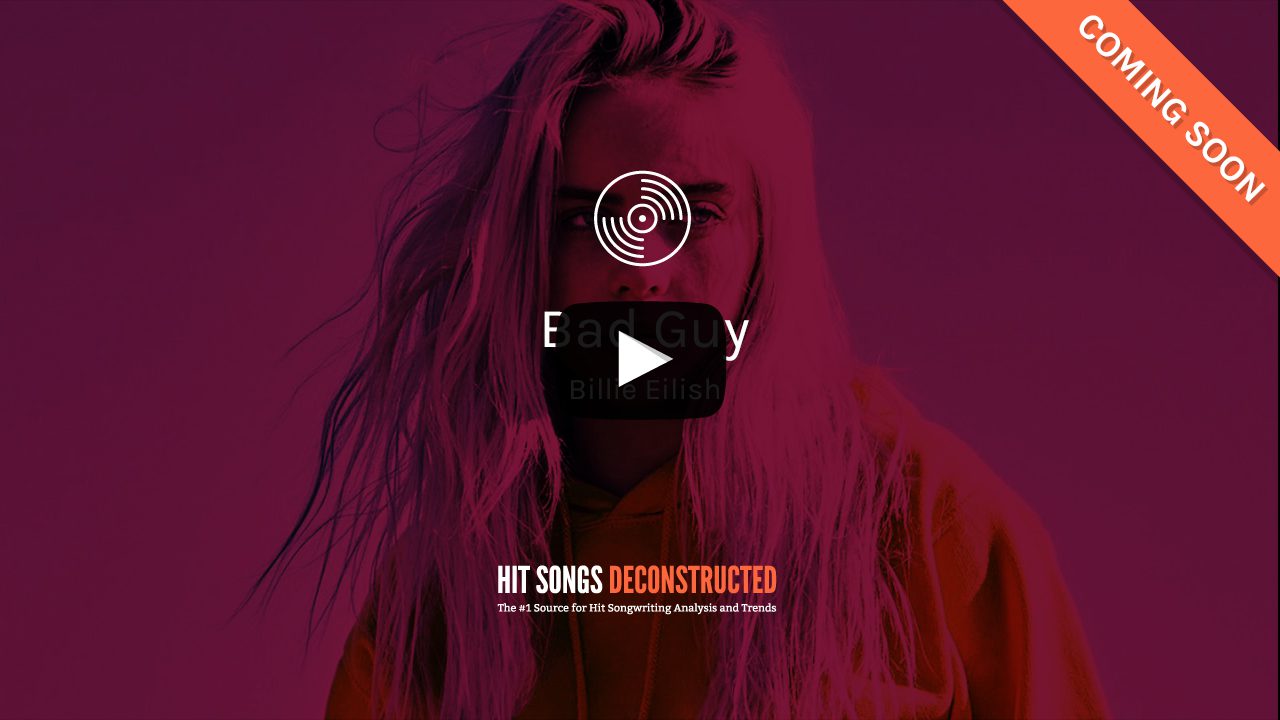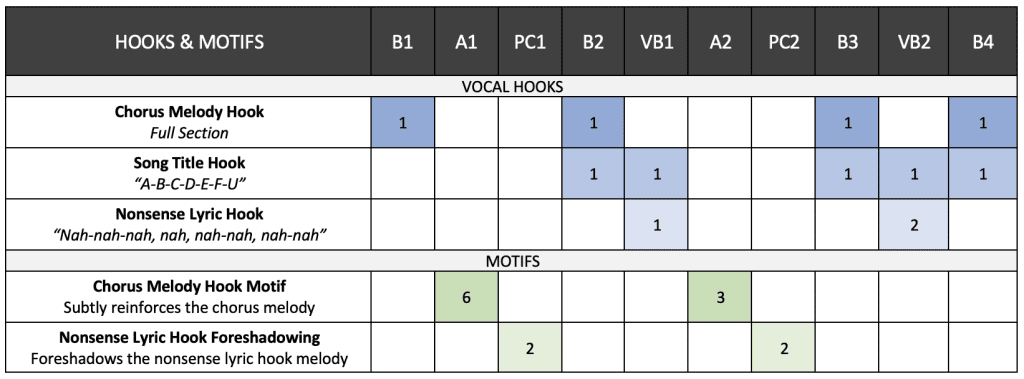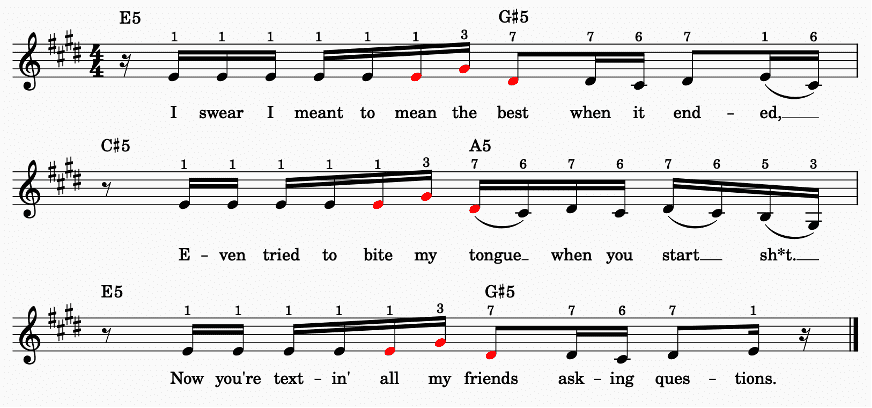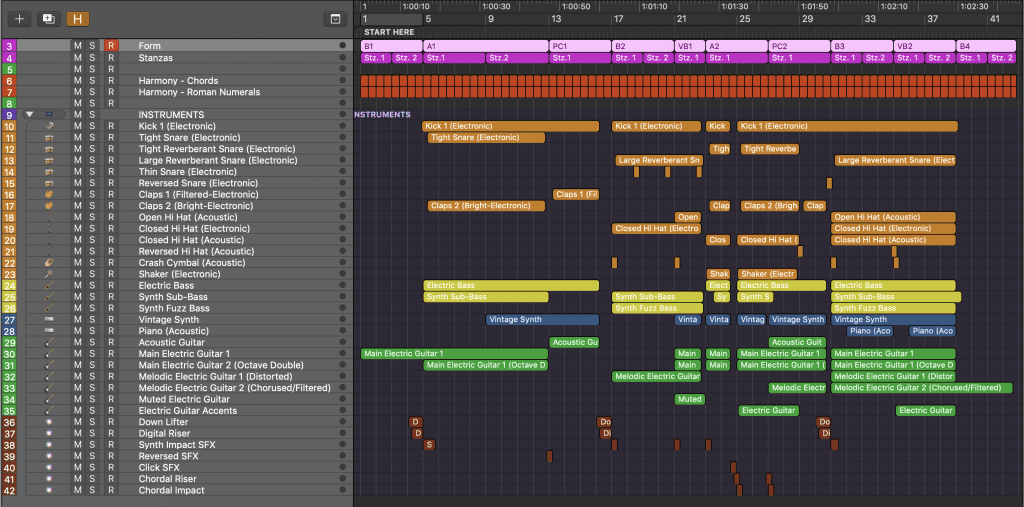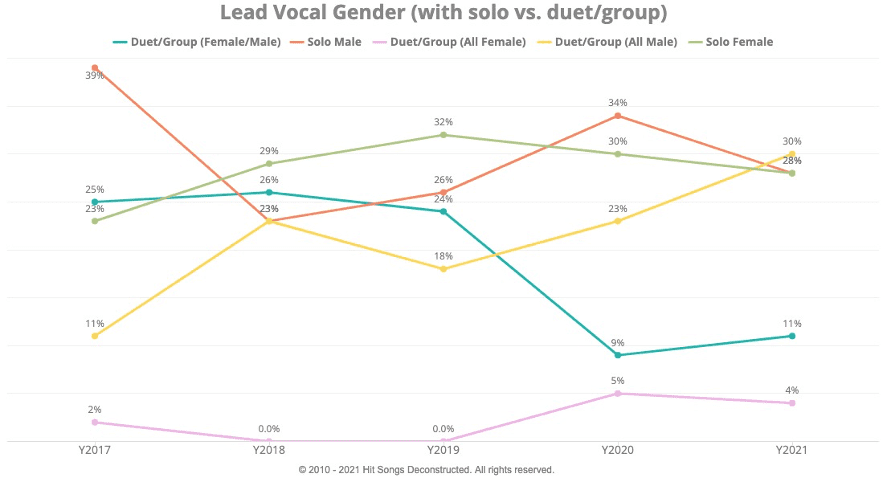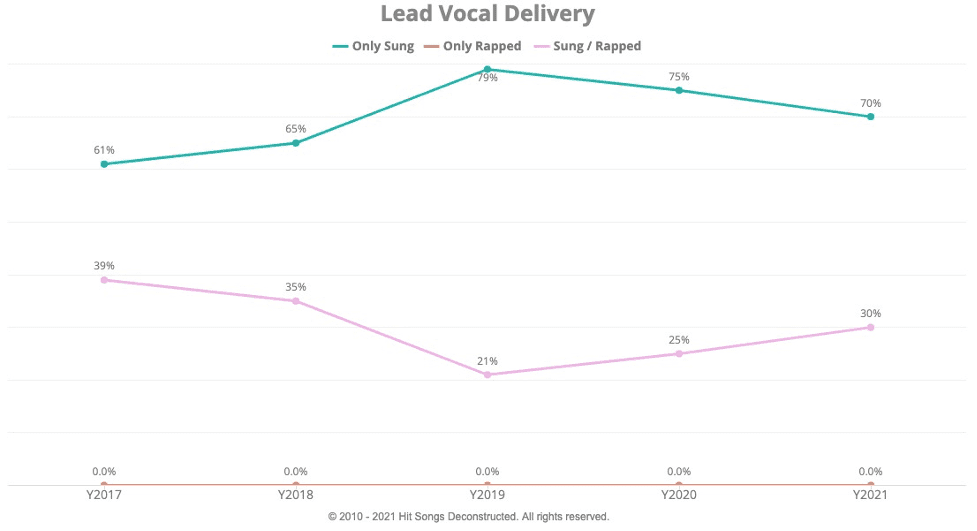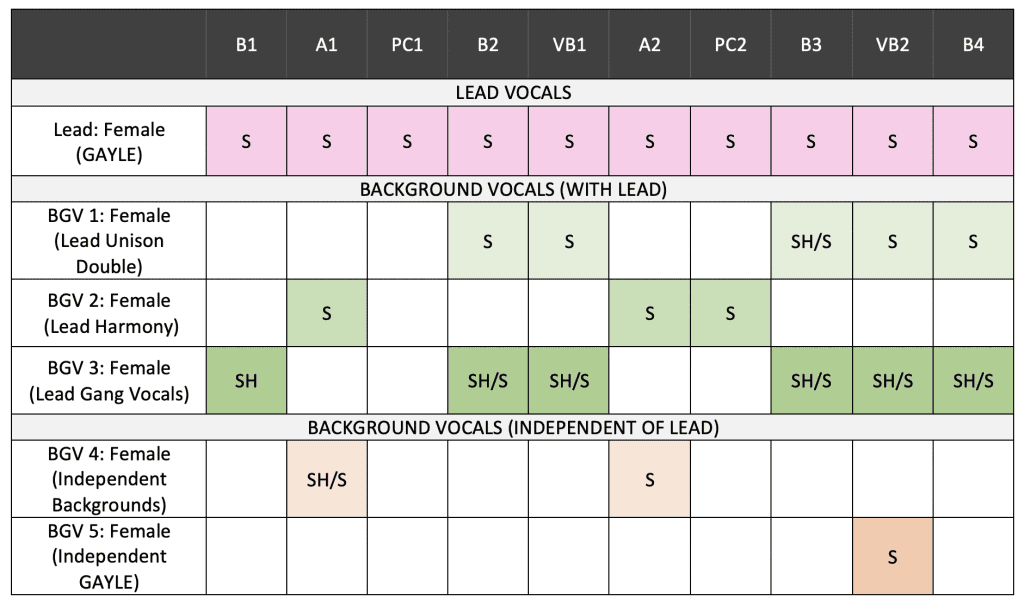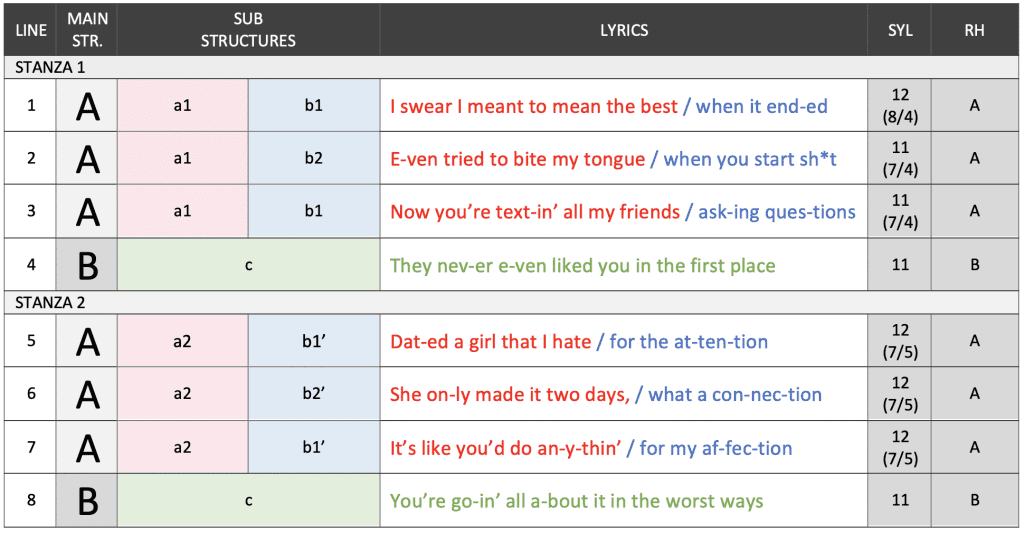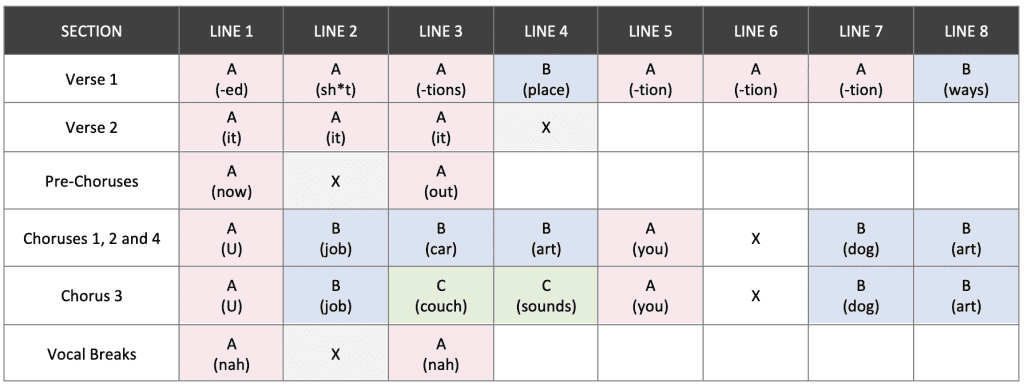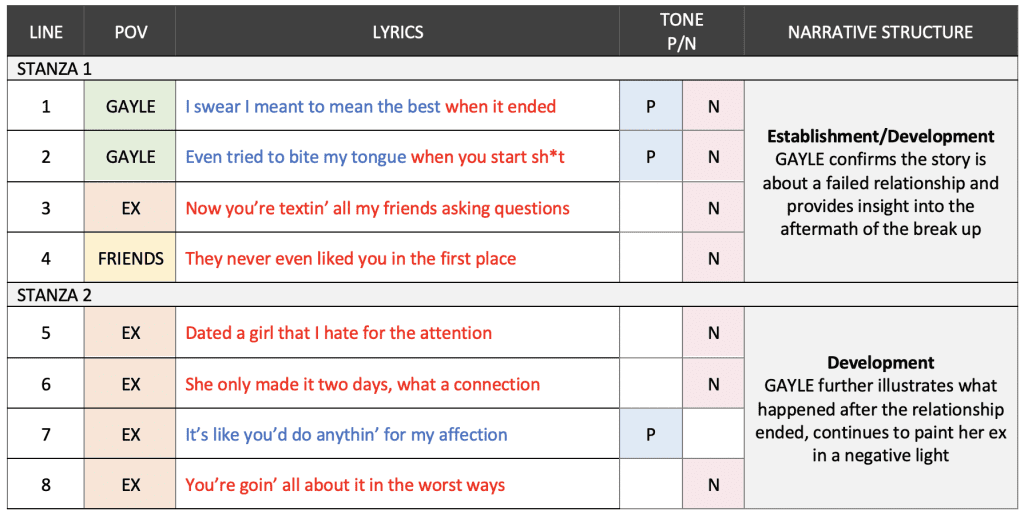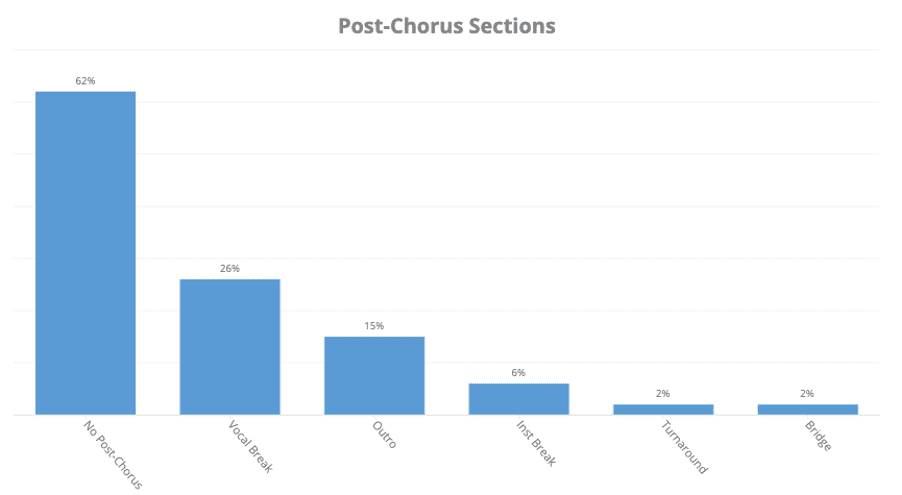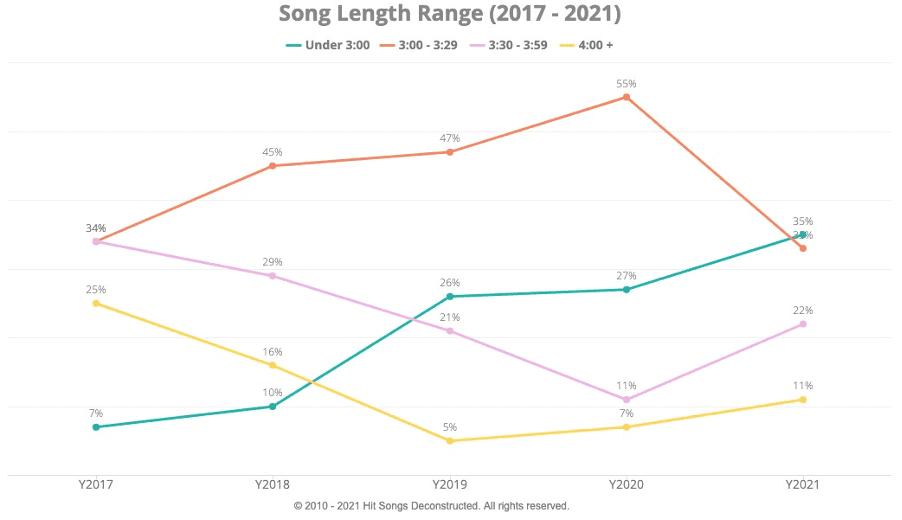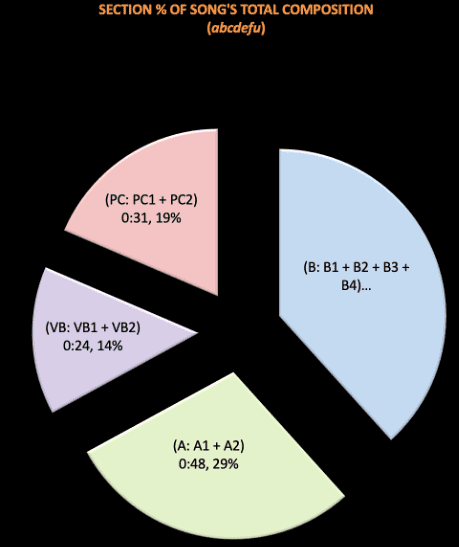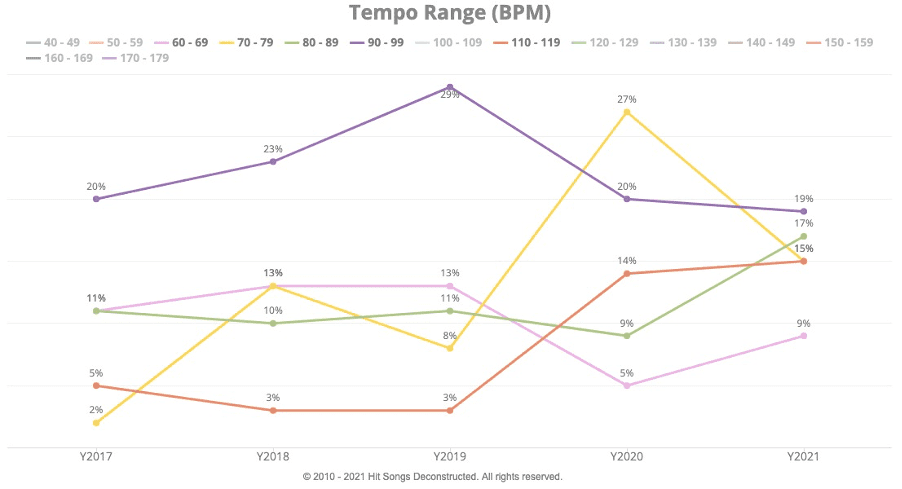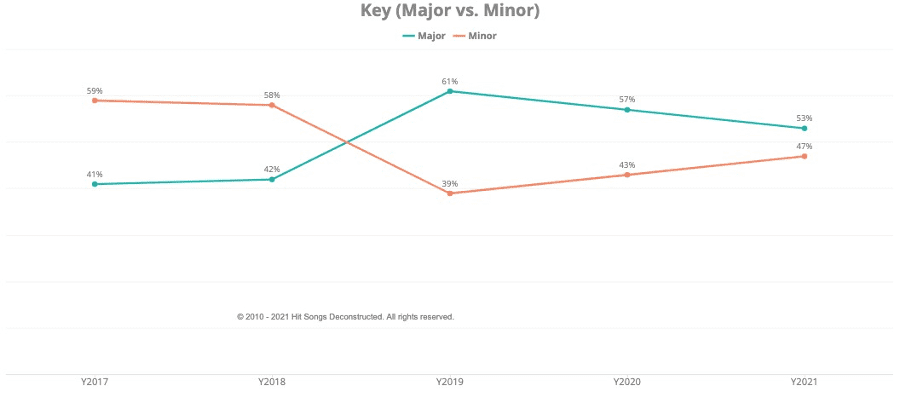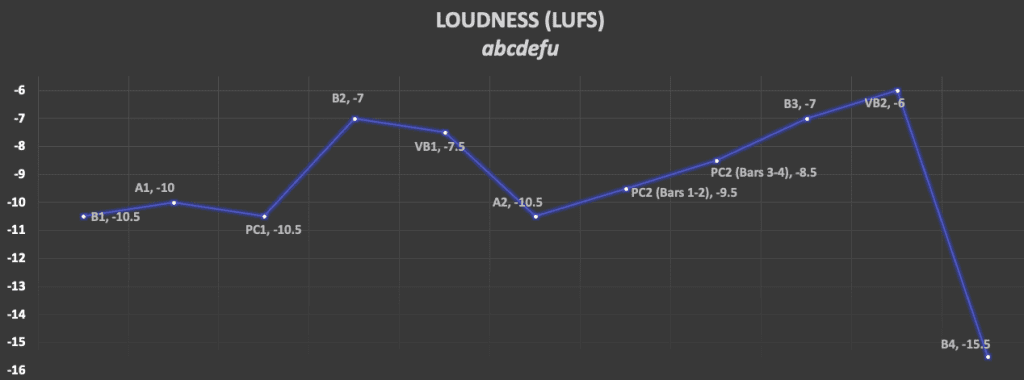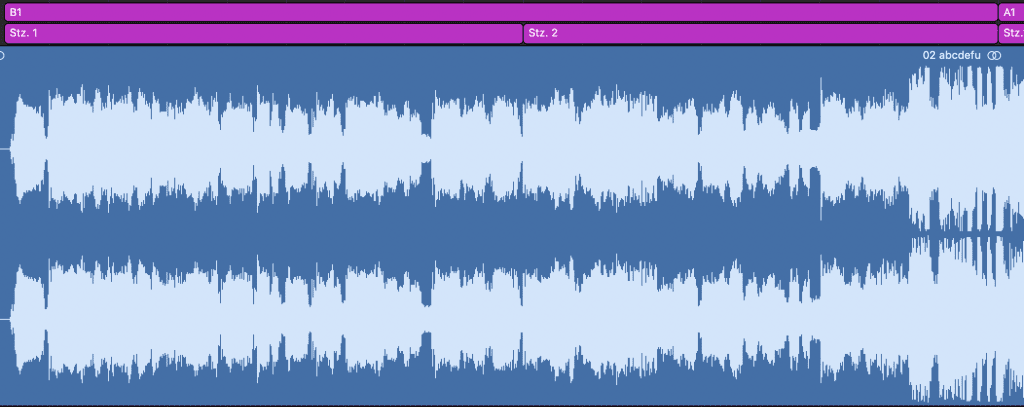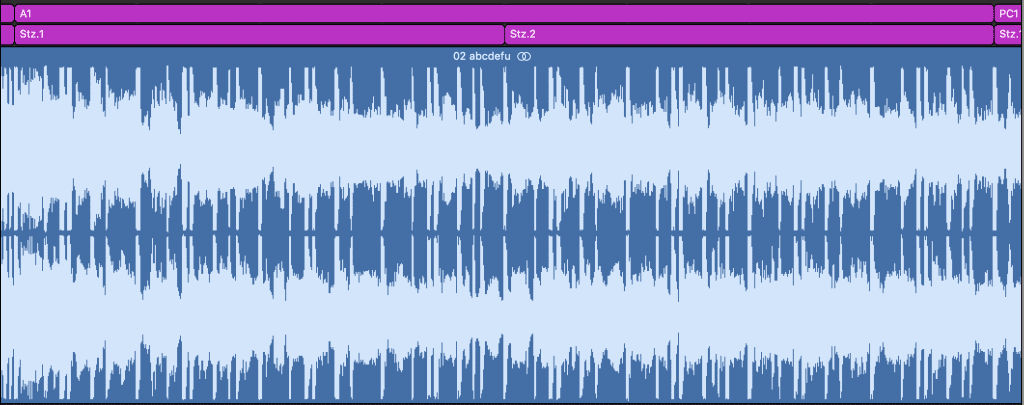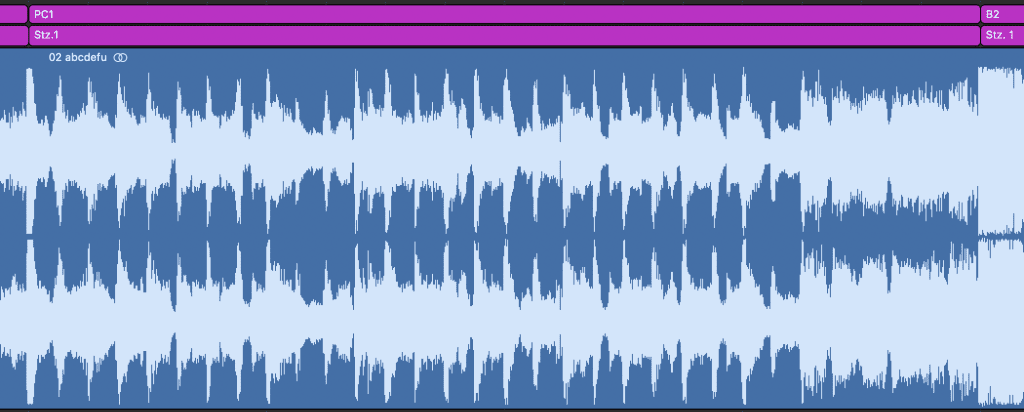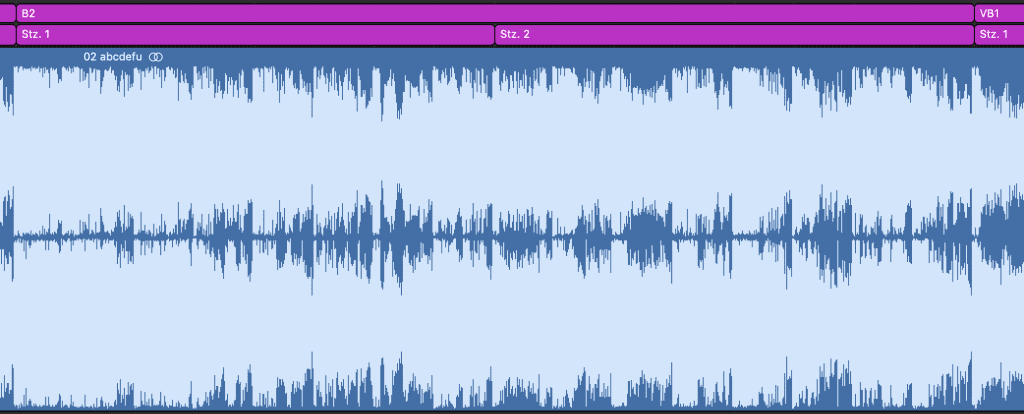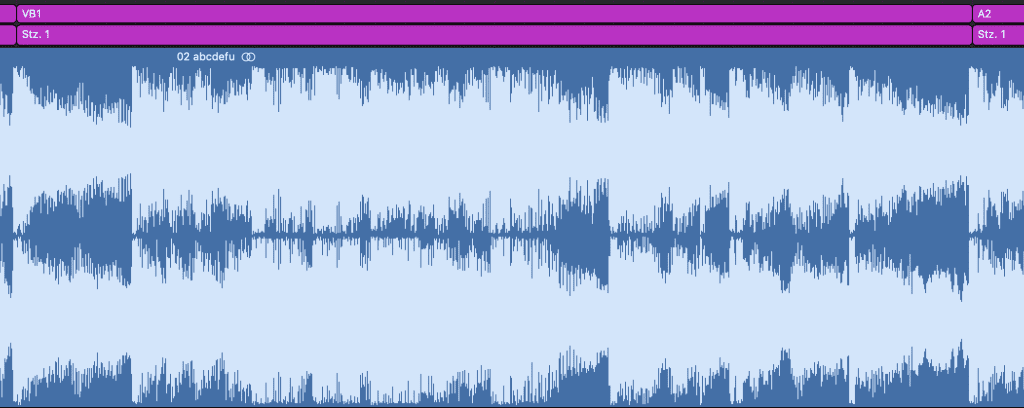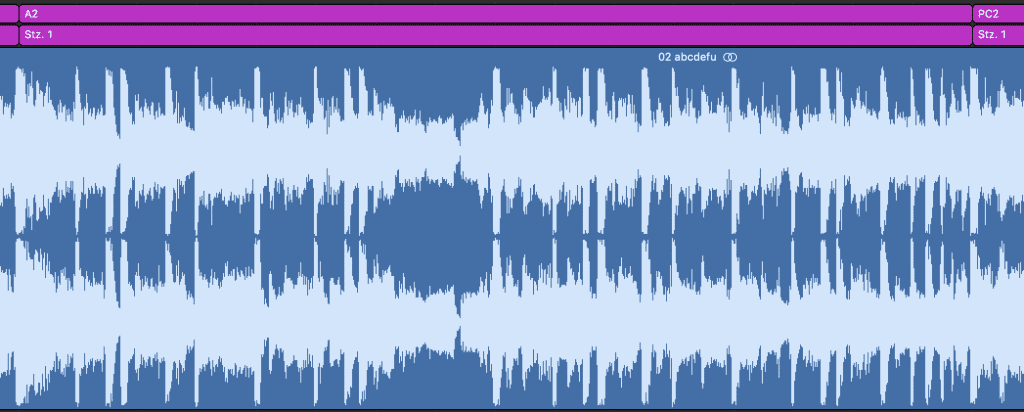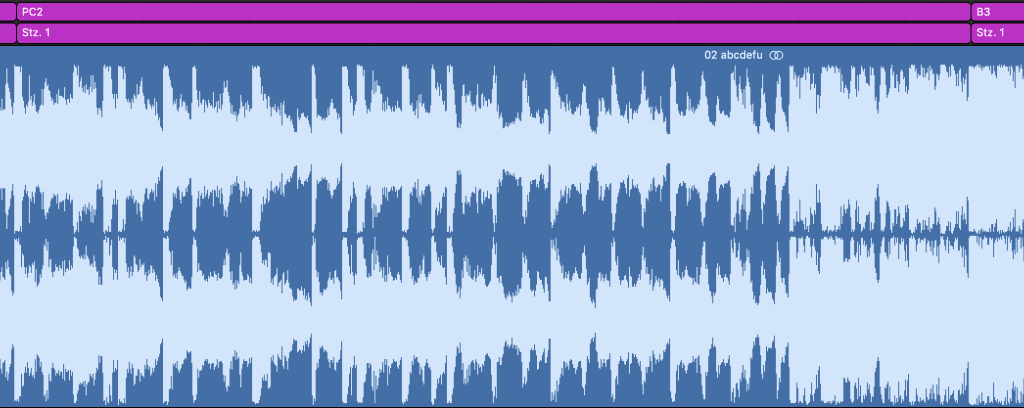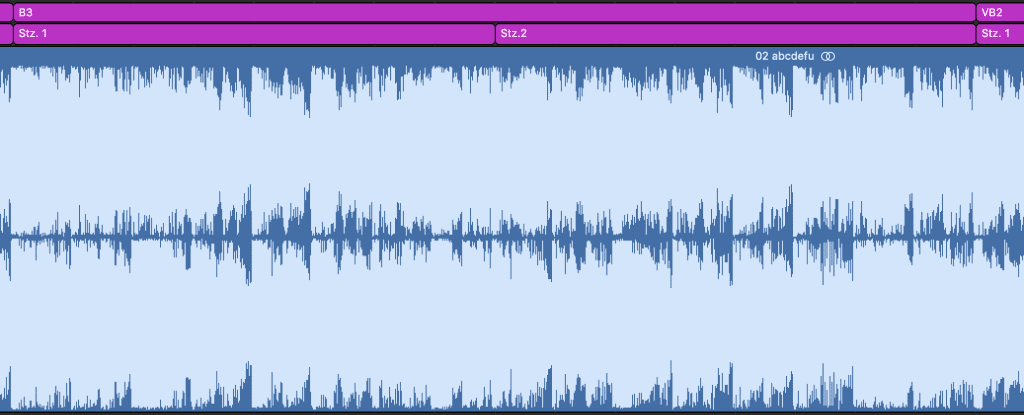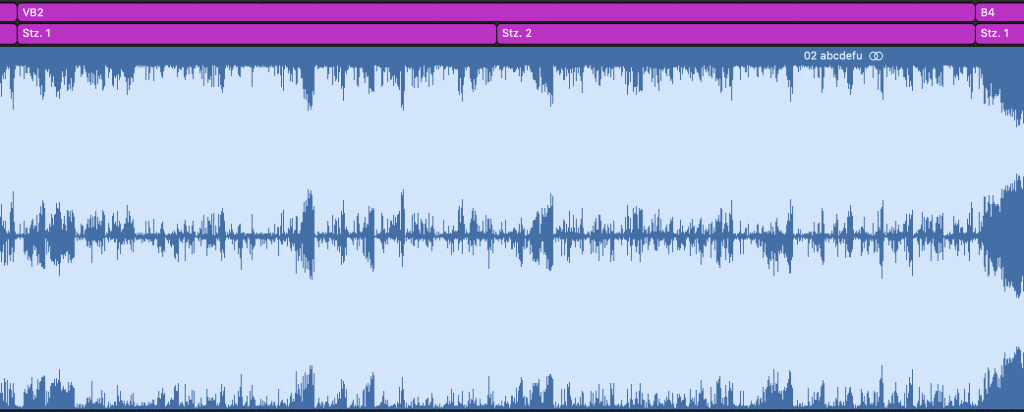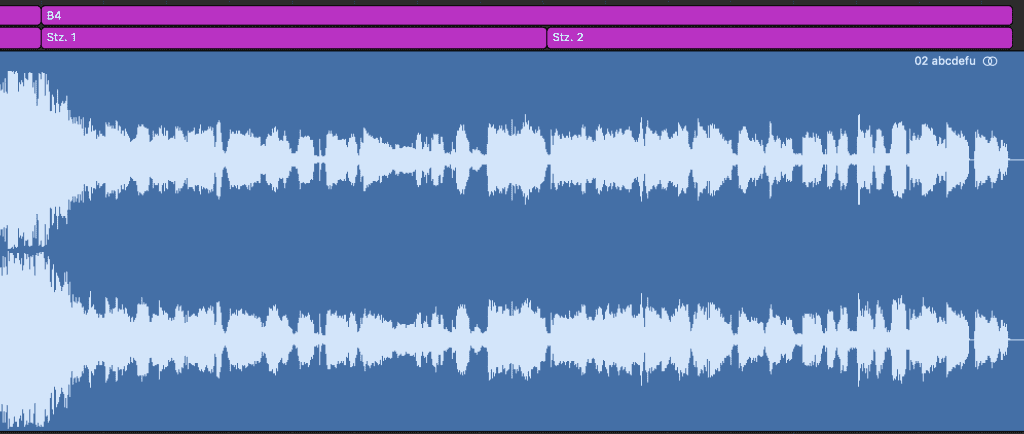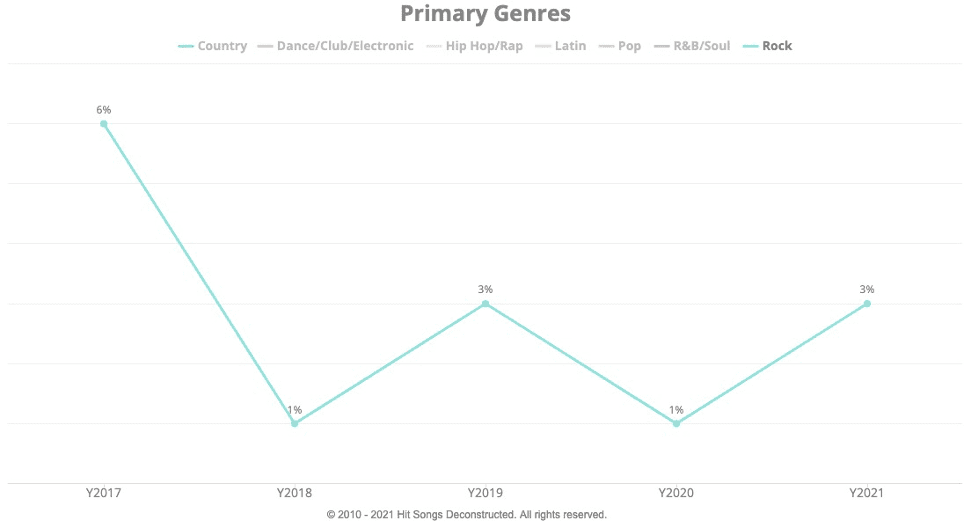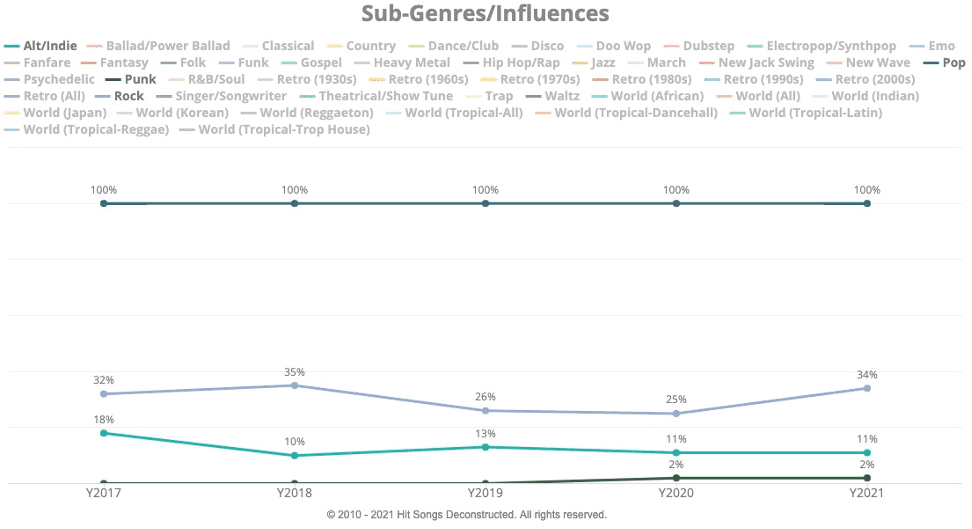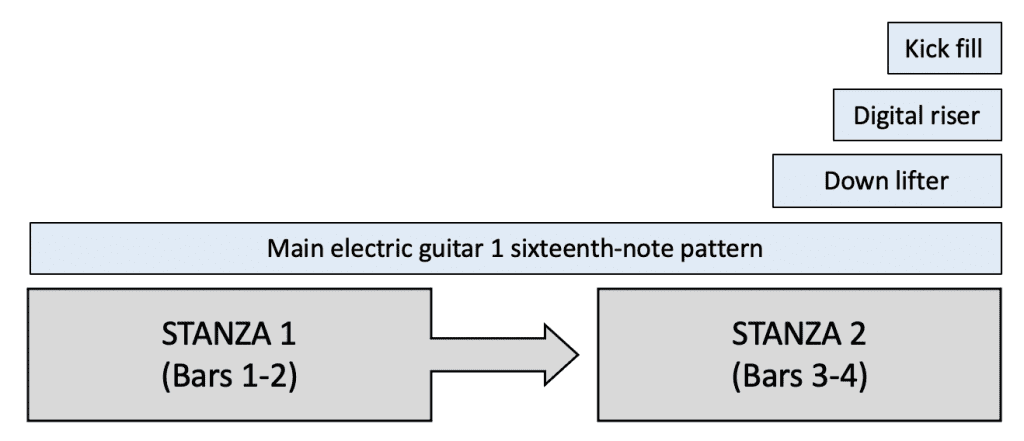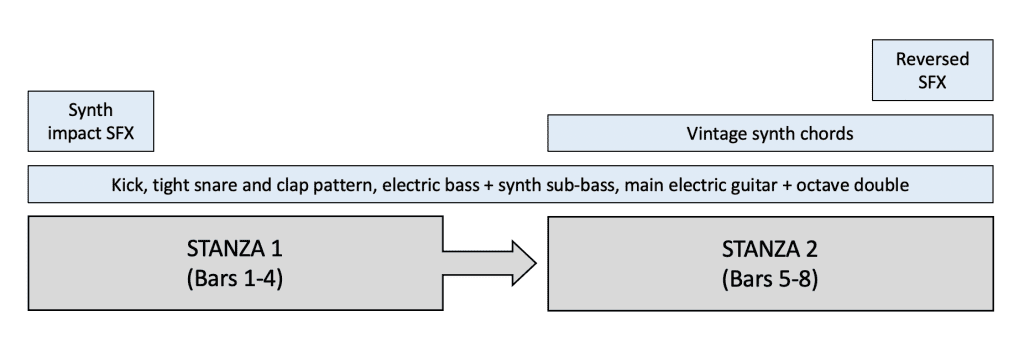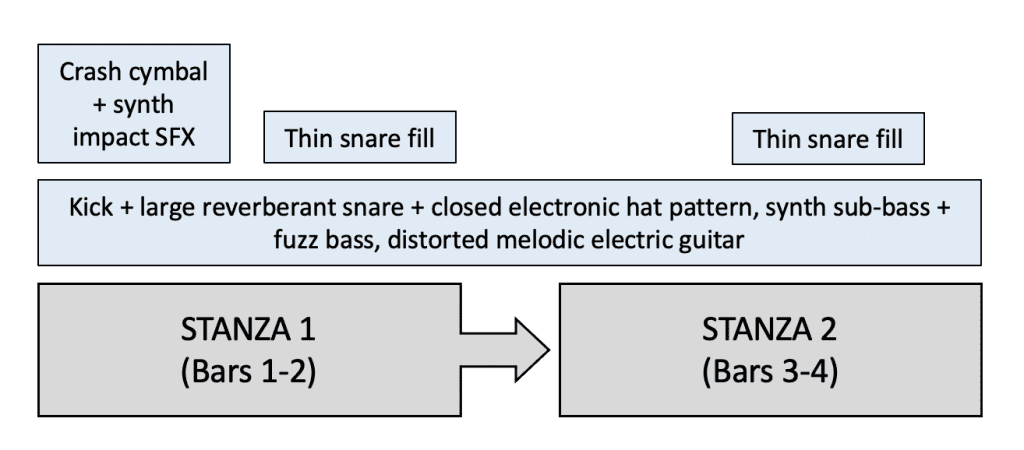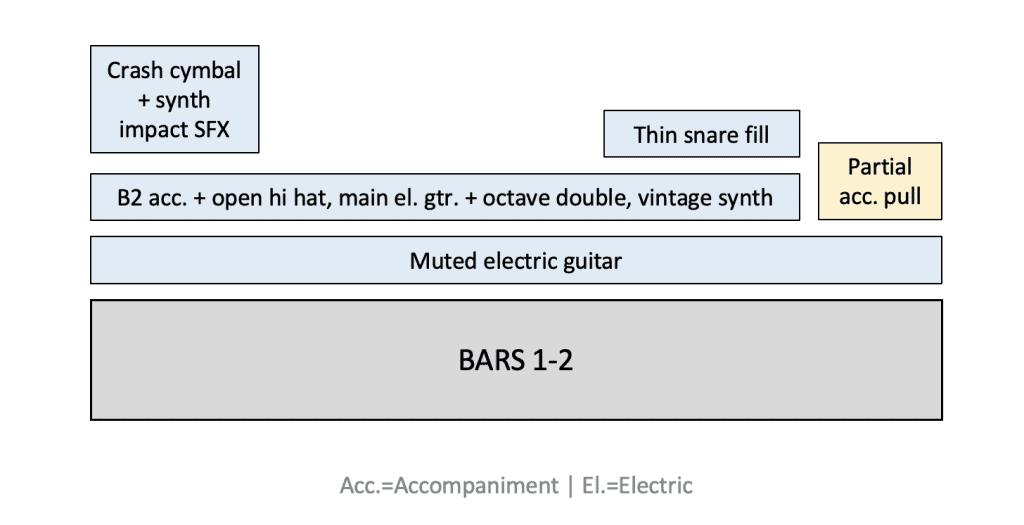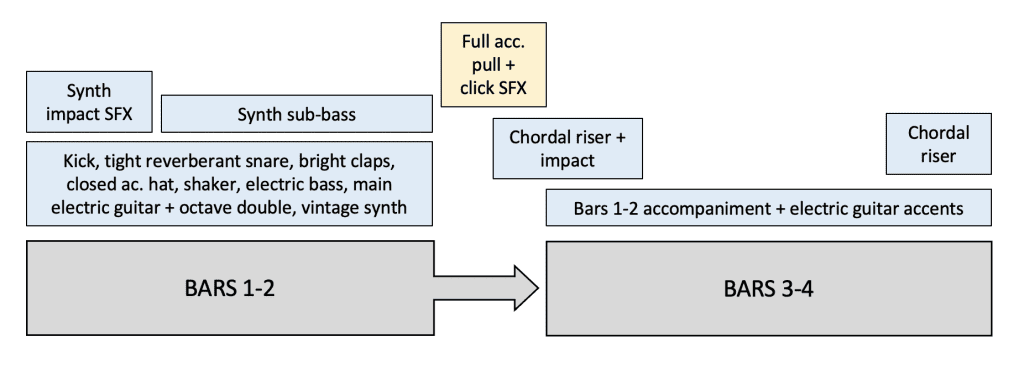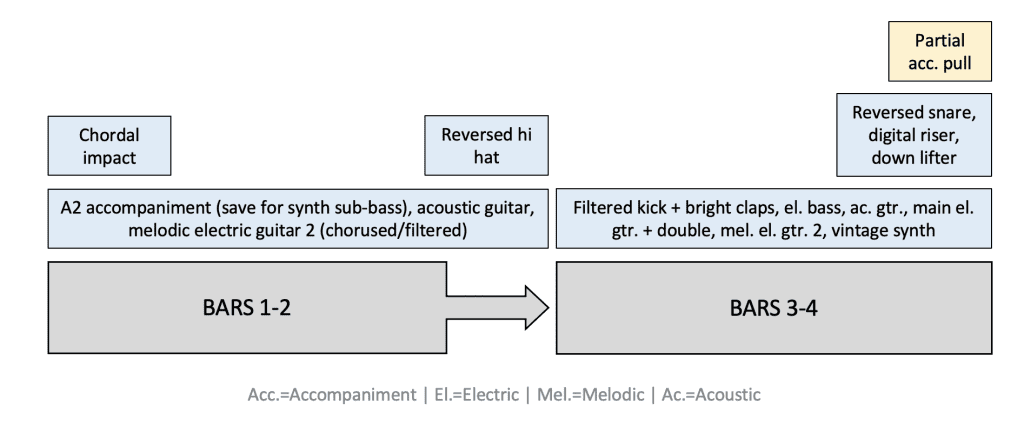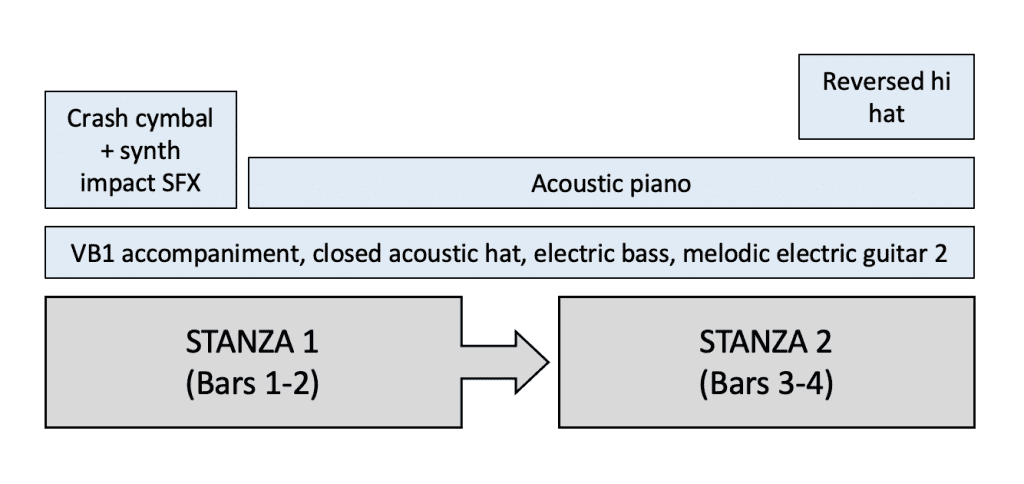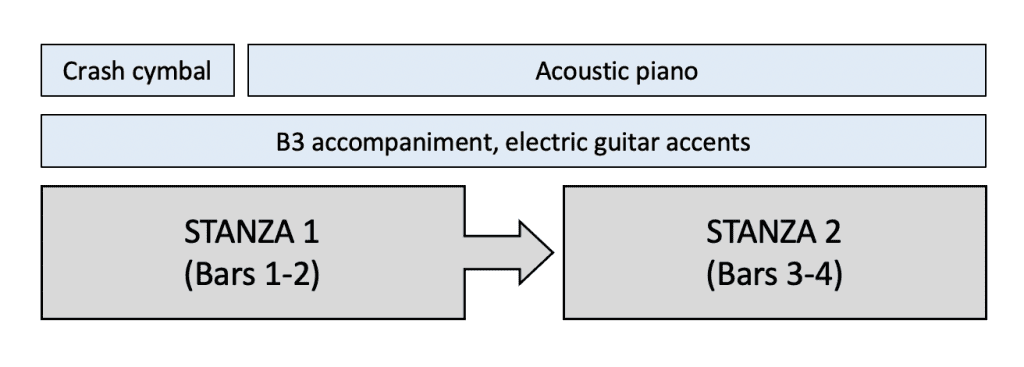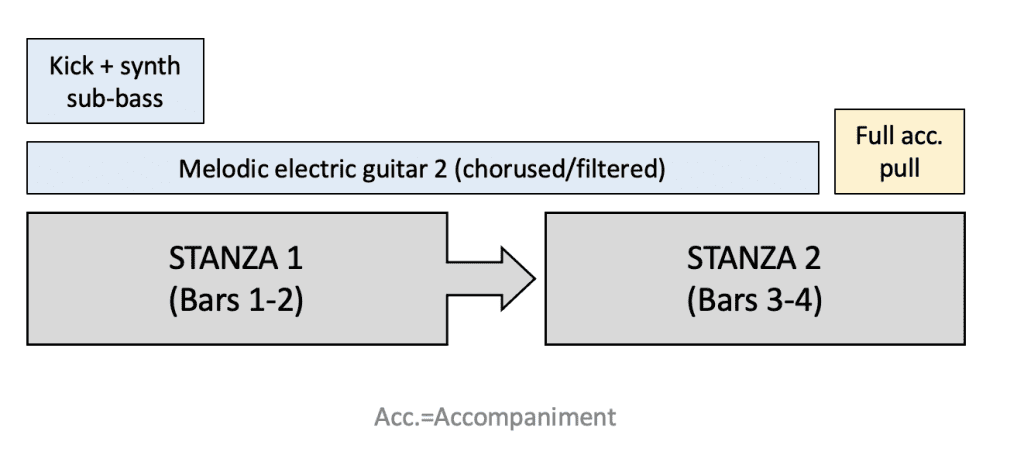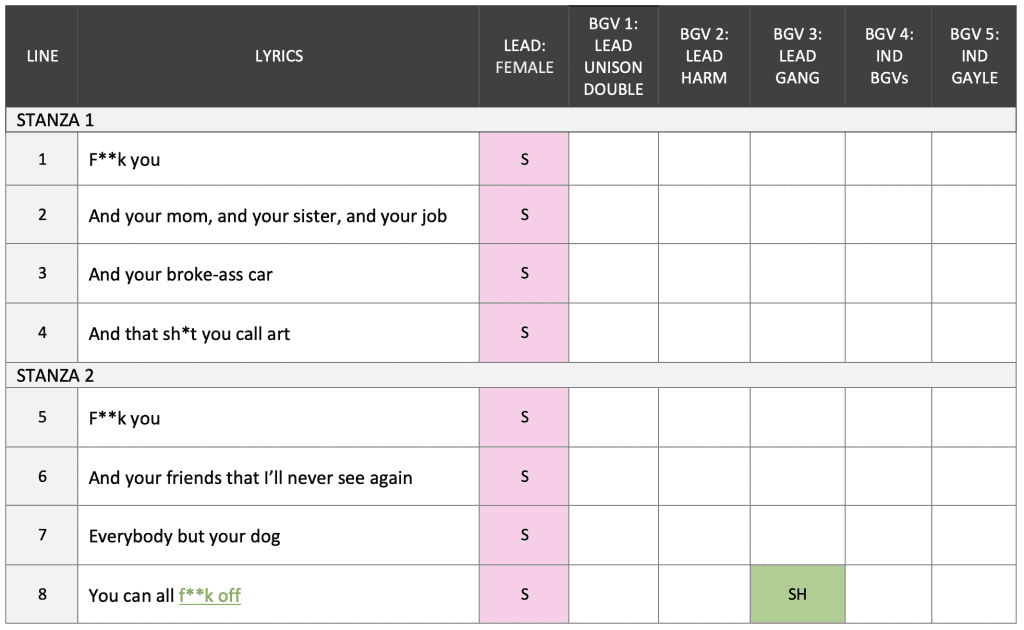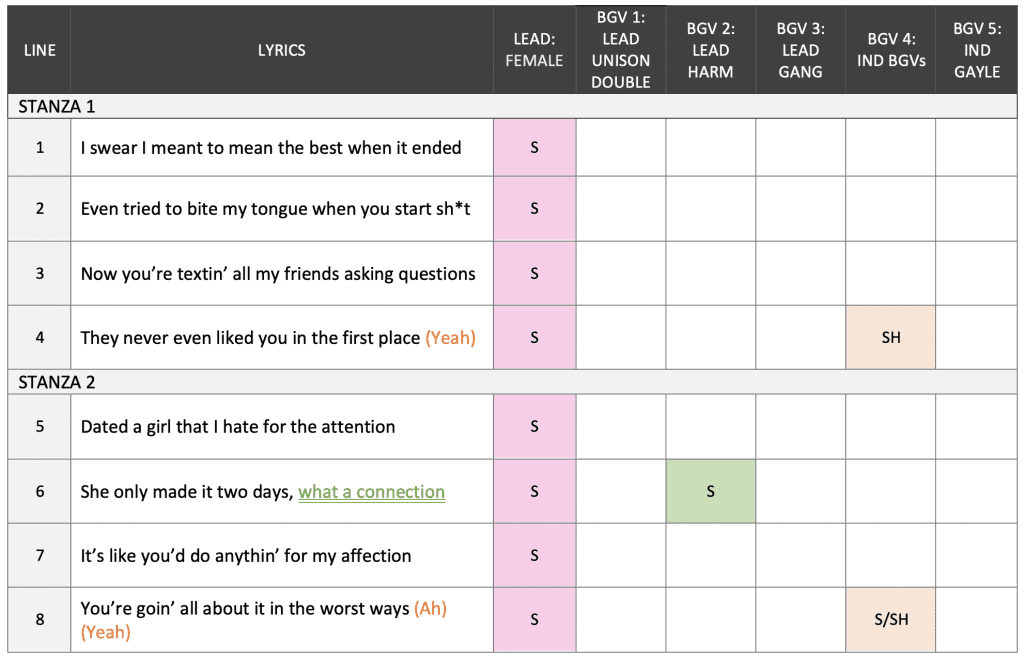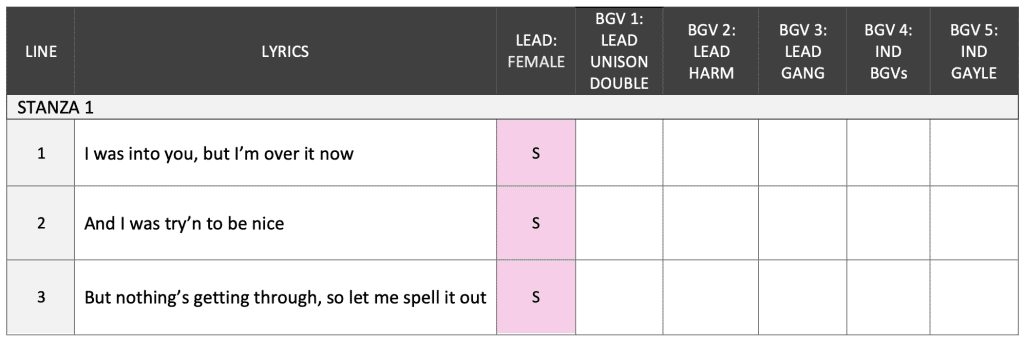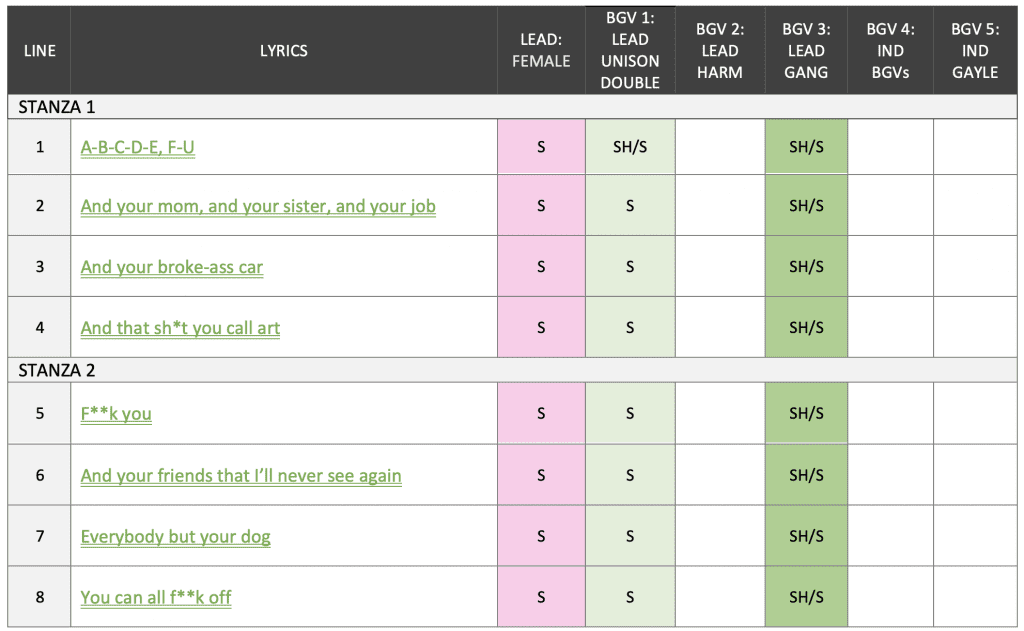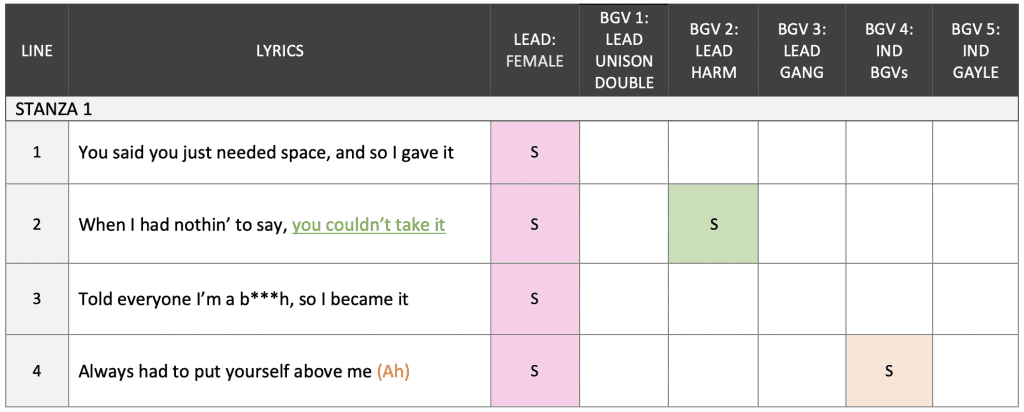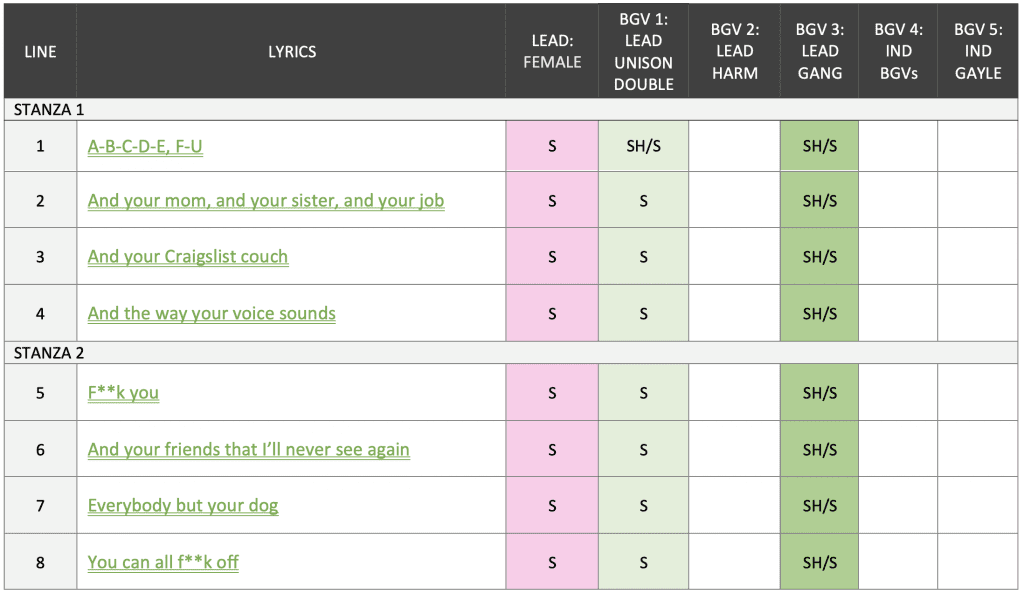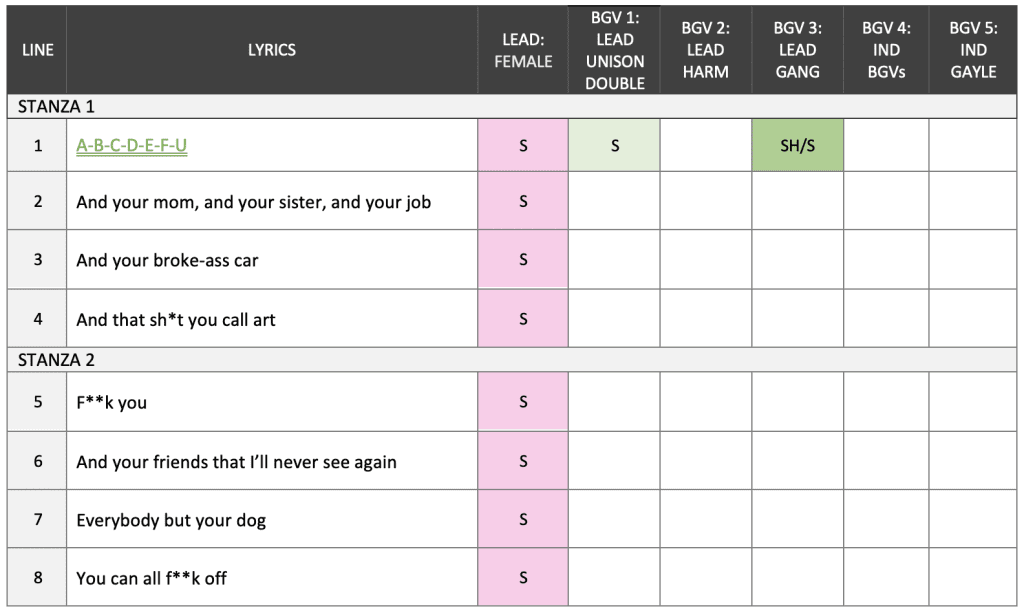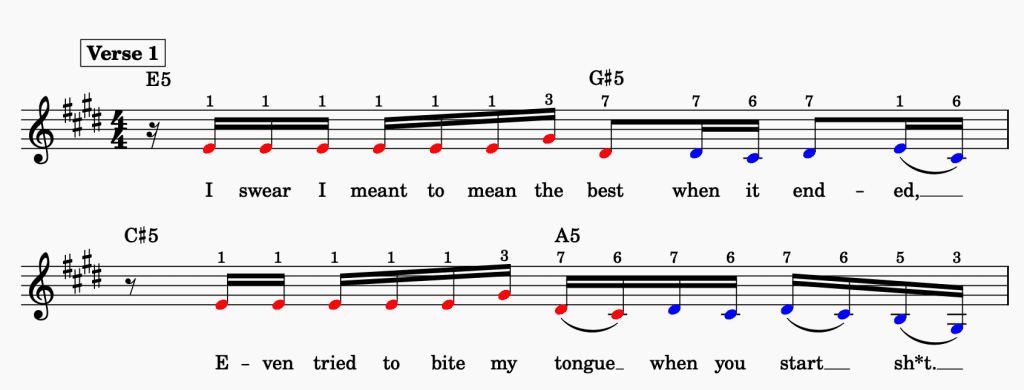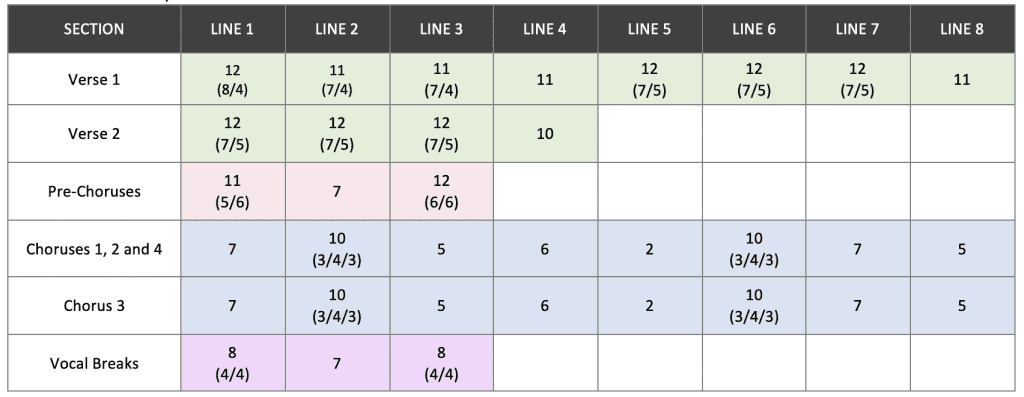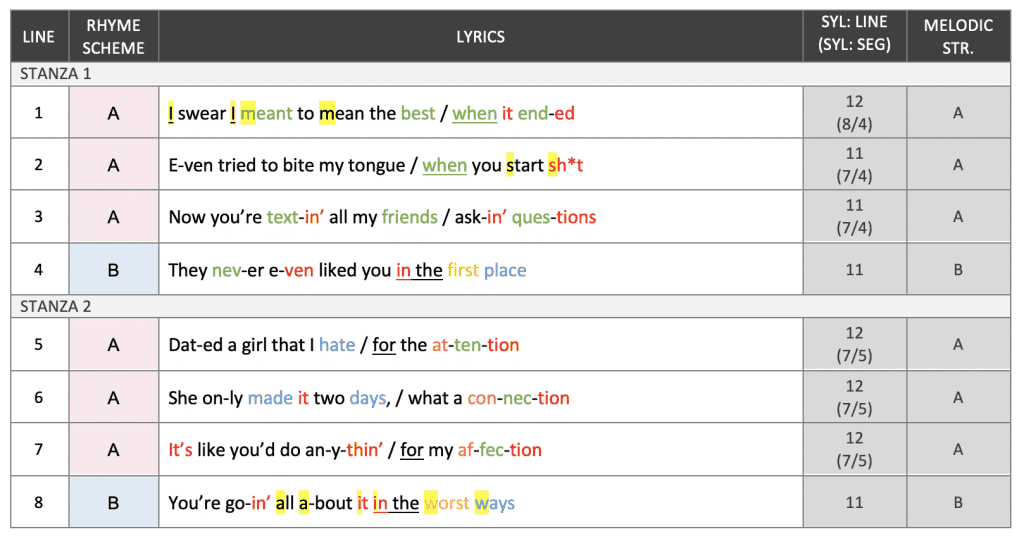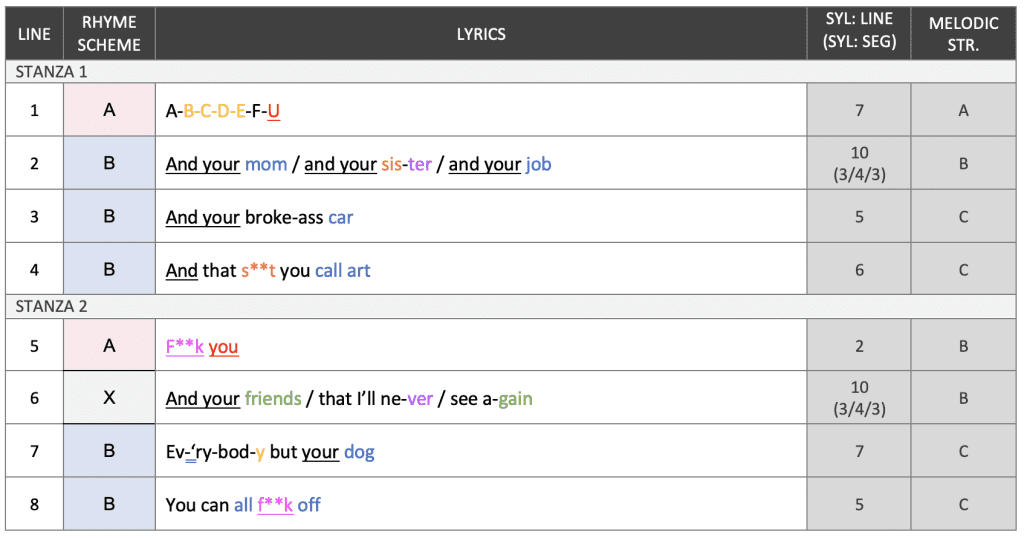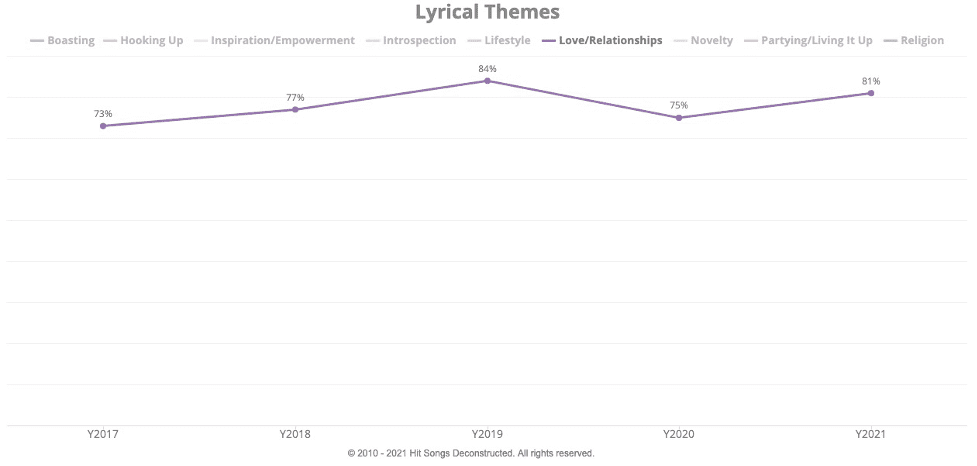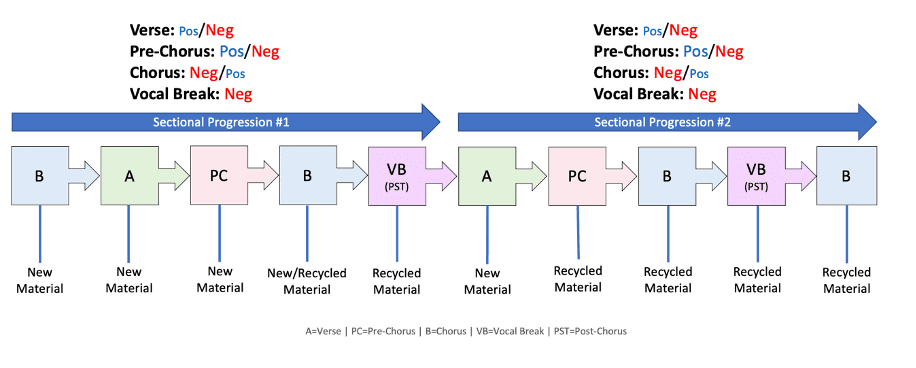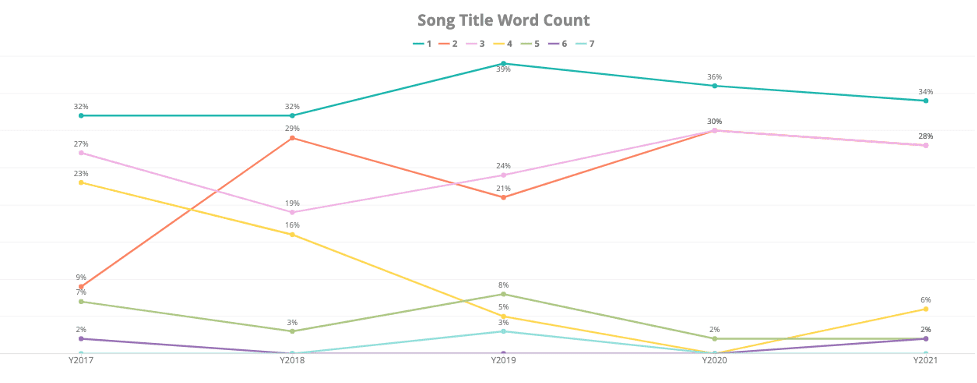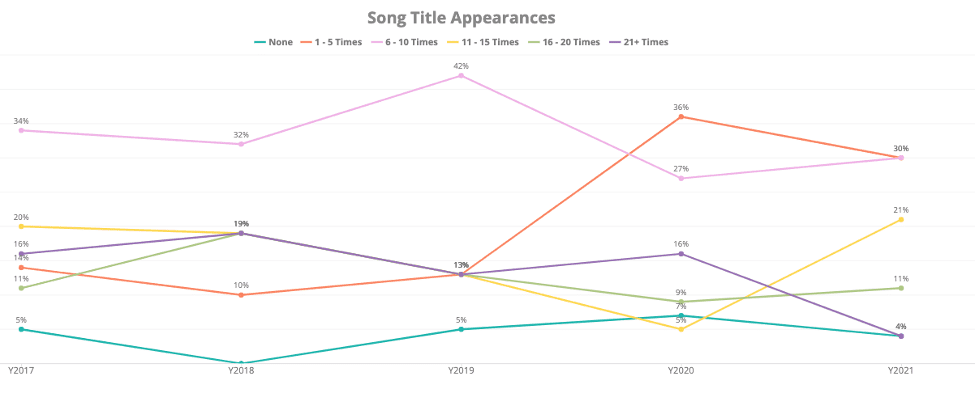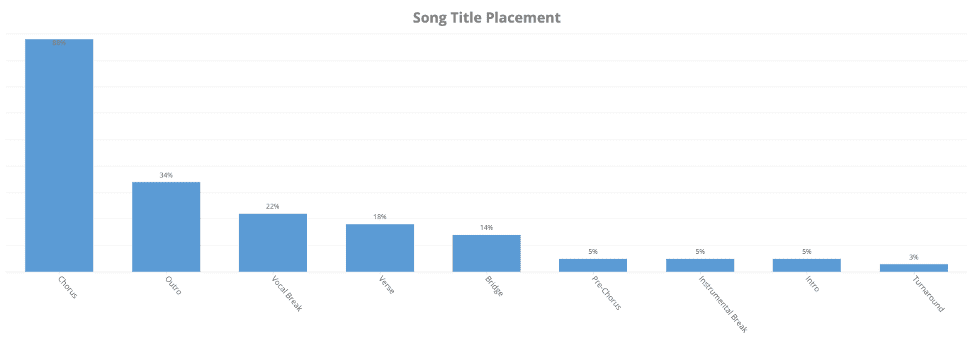About This Report
Hit Songs Deconstructed reports take a deep dive into the what, how, and why behind a current chart-topping hit. These exceptionally comprehensive reports feature a combination of impartial data and insightful analysis illustrated through charts, graphs, and notation.
Based on the Hit Songs Deconstructed PRO report, Essentials delivers high-level takeaways through insightful section-by-section analysis illustrated with charts, graphs and commentary, providing an in-depth understanding of the hit songwriting and production techniques involved in crafting the song.
abcdefu Deconstructed
abcdefu is the breakout hit for Atlantic recording artist and teen sensation GAYLE. Co-written by Taylor Rutherfurd (aka GAYLE), Dave Pittenger, and Sara Davis and produced by Pete Nappi, this scathing breakup anthem has gone viral since its release in the summer of 2021, turning GAYLE into a household name both in the United States and abroad.
abcdefu possesses a mixture of both the familiar and the unique among its Hot 100 Top 10 contemporaries, allowing listeners to easily connect with the song while simultaneously standing out from the pack.
On the familiar side are hit songwriting and production best practices, such as adhering to HSD’s K.I.S.S. ME principle (keep it simple, singable and memorable); using clever hook foreshadowing and reinforcement techniques to bolster familiarity and catchiness while maintaining interest; and keeping the song on the shorter end of the spectrum – namely under the three-minute mark – to name just a few of many. The song also achieves strong prosody between the lyrics, vocals and music to create a unified vibe and heighten the listener’s emotional connection with the song.
However, it is some of the song’s unique and atypical characteristics that help it to stand out from the pack. Perhaps most notable is its clever, shouted “A-B-C-D-E-F-U” song title hook, which provides the defiant summation of the narrative in an A.P.M. (audience participation moment) manner that is primed for a live setting. In addition, the song possesses atypical structural characteristics such as kicking off with the chorus as opposed to the far more popular intro, the omission of a “D” (departure) section, such as a bridge, and having shorter than normal chorus lengths. And lyrically, the song goes against the grain by changing up some of the chorus lyrics, a practice that is largely unheard of in mainstream hits. However, each decision is made with intent and purpose, and serves the song perfectly.
Since its release, abcdefu has achieved great success in an array of mediums and charts, including going viral on the popular app TikTok, peaking at #3 on the Billboard Hot 100, topping the Billboard Global 200, and reaching the Top 10 in over 30 countries across the globe. Additionally, subsequent remixes featuring varying versions of the song, from “nicer” to “chill” to “angrier,” helped to bolster its visibility and reach.
In this report, we’ll be analyzing the factors that contributed to this success, including the song’s structure, vocal melody and production, instrumental arrangement, lyrics, energy, and much more.
Video Deconstruction
At a Glance
Artist: GAYLE
Song: abcdefu
Songwriters: GAYLE, Dave Pittenger, Sara Davis
Producers: Pete Nappi
Mastering Engineer: Daniel Rowland
Mixer: Pete Nappi
Record Label: Atlantic
Primary Genre: Rock
Influences: Alt/Indie, Pop, Punk, Rock
Length: 2:47
Form: B-A-PC-B-VB-A-PC-B-VB-B
Key: E Major
Tempo: 61 BPM
First Chorus: Kickoff (0:00)
Electronic vs. Acoustic Instrumentation: Primarily Electronic
Prominent Instruments: Bass (Synth), Claps, Drums/Percussion (All), Drums/Percussion (Primarily Electronic), Guitar (Acoustic), Guitar (Electric), Synth (Non-Bass)
Primary Lyrical Themes: Love/Relationships
Title Appearances: abcdefu appears 5 times in the song
Section Abbreviation Key
A=Verse
PC=Pre-Chorus
B=Chorus
VB=Vocal Break
Music notation and lyric excerpts are reproduced here under Fair Use terms, for the purposes of commentary and criticism.
KEY
A=Verse | B=Chorus | PC=Pre-Chorus | VB=Vocal Break
Number: Denotes the number of times that a particular hook/motif appears within a section
abcdefu’s Hook Arrangement
abcdefu’s first hook is heard right at the top of the song in chorus 1. Here, the listener is immediately “hooked” into the song with the chorus melody hook, which delivers the scathing lyrics with a simple, repetitive pattern that is reminiscent of popular nursery rhymes (see the vocal melody section of the report for more details).
Following the chorus, the listener gets a hook respite in the verse and pre-chorus sections, which is highly characteristic of mainstream hits. However, these two sections feature motifs that subtly reinforce and foreshadow other key hooks in the song, which makes abcdefu even more cohesive, catchy and memorable. The 1-3-7 verse motif subtly reinforces the 1-3-1 and 1-3-7 melodies heard throughout the chorus, and the pre-chorus melody is highly similar to the “nah” nonsense hook melody heard in the vocal break post-choruses.
Following the pre-chorus, the song heads into chorus 2, which has been developed over chorus 1 to include the first instance of the song-defining “A-B-C-D-E-F-U” song title hook. Cleverly set up by the “so let me spell it out” lyric at the end of the pre-chorus, the hook stands out through its quasi-sung/shouted A.M.P. (alternating melodic pattern) delivery over a partial accompaniment pull S.I.A. (section impact accentuator). The ensuing vocal break post-chorus then reinforces the song title hook along with the first instance of the aformentioned “nah” nonsense hook, which cleverly bolsters the summation’s dismissive tone through its subtle resemblance to Steam’s 1969 hit, Na Na Hey Hey Kiss Him Goodbye.
Verse 2 and pre-chorus 2 then fall in line with their first occurrence counterparts, providing hook respites while subtly reinforcing hook melodies heard previously in the song. The last three sections of the song – chorus 3, vocal break post-chorus 2 and chorus 4 – all reinforce their previous counterpart’s hooks, albeit with some modified qualities to prevent redundancy. Chorus 3 changes up some of the lyrics (reference the narrative section of the report for details); vocal break post-chorus 2 is twice the length of its first occurrence counterpart and features a denser arrangement and a slight lyrical changeup; and chorus 4 breaks down to a sparse arrangement along with some slight melodic differences compared to the other choruses.
Together, the effective combination of hook foreshadowing, reinforcement, modification and respites creates a highly catchy and memorable listening experience that never wears out its welcome.
Chorus Melody Hook
Chorus Melody Hook Motif
Song Title Hook
Nonsense Lyric Hook
Nonsense Lyric Hook Foreshadowing
abcdefu possesses both structural commonalities and differences compared to recent non-hip hop Hot 100 Top 10 hits. On the more common side are its two, easy-to-follow, verse – pre-chorus – chorus – vocal break post-chorus sectional progressions; allocating the greatest amount of time in the song to the chorus; and its short, under three-minute song length, to name a few.
Balancing out its more familiar qualities are unique characteristics such as its omission of popular sections including the intro, “D” section and outro; immediately kicking off with the chorus as opposed to an intro; and featuring shorter than average choruses. While atypical, these decisions were all strategic choices made by the writers and producers.
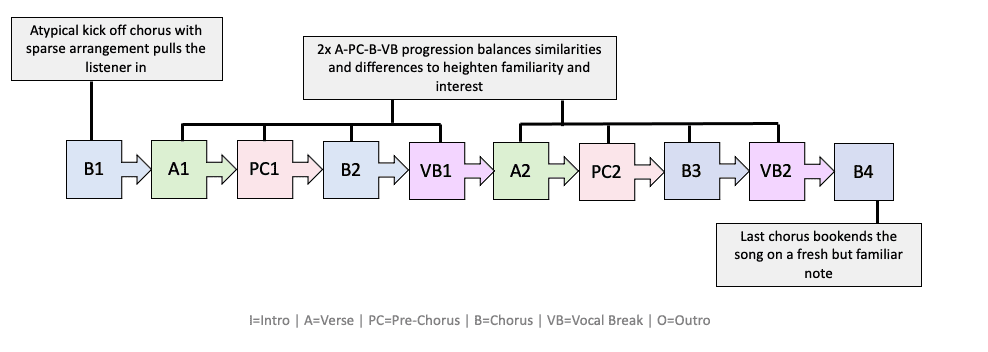


abcdefu is a rock song with a combination of pop, punk and alt/indie influences.



abcdefu features an expertly crafted instrumental arrangement that achieves a lot in its short runtime. At its heart is a strategic assortment of mix elements including electronic and acoustic drums and percussion, electric and acoustic guitars, electric and synth basses, keys, and a host of effects. Together, along with their varying timbres, textures and patterns, they create an engaging sound pallet that is rooted in “traditional” guitar-driven rock while simultaneously appealing to a modern pop audience.
But perhaps most notable is the methodical manner in that the arrangement unfolds over the course of the song. In addition to creating an effective balance of engagement and familiarity across sections, which is the hallmark of a strong arrangement, the manner in that it supports the vocals and lyrics to create effective prosody and heighten the listener’s emotional connection with the song is its true brilliance.
From the solo guitar bookending chorus arrangements that support GAYLE’s subdued delivery of the scathing lyrics, to the dense, high-energy mid-song chorus payoffs that put the chorus lyrics in a new angrier context along with the shouted gang vocals, to the timbral thinning of the acoustic guitar-driven pre-chorus 1 arrangement that effectively sets up the ensuing chorus along with the higher-register vocals, these accompaniment shifts provide abcdefu with heightened emotional dimension that deepens the listener’s connection with the song, and the artist.
abcdefu progresses through two energy level “waves.” Each flows from low to high, with peaks in the vocal break post-choruses, save for the lower energy “wind down” fourth chorus at the end. It features an effective combination gradual and pronounced energy shifts, complimenting loudness shifts, tradeoffs between power and momentum, and impactful S.I.A.s (section impact accentuators), all of which come together to create an engaging listening experience that keeps the listener locked in from start to finish.
abcdefu features on chord progression that is kept interesting through a variety of delivery styles throughout the song.
E5 – G#5 – C#5 – A5
abcdefu features a solo female lead vocal from GAYLE. Generally hovering between one-quarter and one-third of non-hip hop Hot 100 Top 10 hits over the past five years, solo female leads have been trading off with solo male leads for top billing up until 2021, when they tied and slightly trailed all-male duet/group vocals.
Lead Vocal Gender in Hot 100 Top 10 (Non-Hip Hop Hits): 2017 – 2021
abcdefu features an exclusively sung lead vocal delivery. Not surprisingly, non-hip hop Hot 100 Top 10 hits that feature exclusively sung lead vocals have by far been the most popular over the past five years and beyond, with 70% of songs in 2021.
Lead Vocal Delivery in Hot 100 Top 10 (Non-Hip Hop Hits): 2017 – 2021
In addition to the lead, abcdefu features a host of background vocals including harmonies, unison doubles, sung adlibs, and shouted gang vocals.
abcdefu features minimal vocal effects and processing, including reverb, delay and autotune, all of which maintain an intimate vibe while adhering to mainstream vocal production standards.
Lead: Female (GAYLE): GAYLE’s lead vocal
BGV 1: Female (Unison Double): Background vocal doubles in unison with the lead
BGV 2: Female (Lead Harmony): Background vocal that harmonizes with the lead on different pitches
BGV 3: Female (Lead Gang Vocals): Background vocals that are tracked many times to create a large “crowd” effect
BGV 4: Female (Independent Backgrounds): Background vocals featured independently from the lead
BGV 5: Female (Independent GAYLE): Lead vocals that are independent embellishments
Key
BGV: Background vocals
S: Sung
SH: Shouted
/: Separates stanzas in sections where a certain vocal type occurs in only one stanza
Chorus
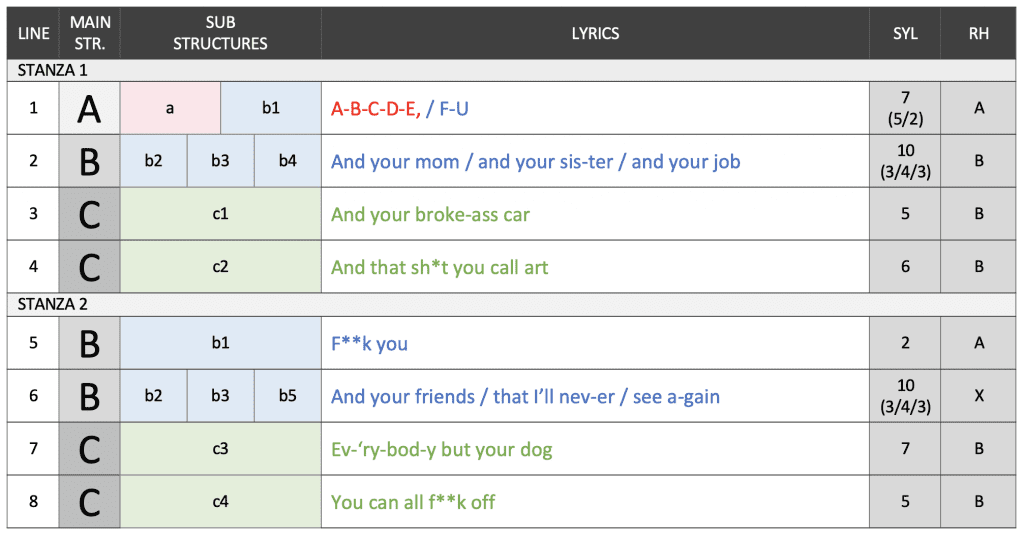


*Note that while choruses 1 and 4 feature slight variations melodically, chorus 2 is most indicative of the chorus melody, with the differences noted in the analysis below
abcdefu features expert use of rhymes and other connection accentuators that ensure the song remains lingering in the listener’s head long after it ends. Among them are logically unfolding end-of-line rhyme schemes, strategically placed internal rhymes, double and triple rhymes, alliteration, repetitive lyrics, and the mirroring between rhyme schemes, syllabic structure and melodic structure to heighten cohesion and connectability.
Key
A, B & C: End-of-line rhymes
X: Non-rhymes
Lyrics: The primary rhyme at the end of each line
Colors and rhyme schemes are unique to each section
abcdefu is a love/relationships-themed song about a protagonist (GAYLE) who experiences a teenage heartbreak and is deeply angered by her ex’s behavior following the breakup. Her feelings are succinctly summarized with the clever song title hook “A-B-C-D-E-F-U,” a play on the alphabet that both insults her ex’s intelligence while telling them off in a particularly scathing and memorable manner.
Throughout the song, a host of expert lyrical techniques are employed that go both with and against the grain. Among the more common are delivering the relatable lyrics in a conversational manner, using an effective balance of common and clever lyricism, incorporating aspects of the A.I.D.E. principle (action, imagery, detail devices, emotion) to heighten interest, featuring a nonsense lyric hook, and the logical unfolding of lines both within and across sections, to name just a few.
Conversely, the song goes against the grain most notably with its chorus. Among its atypical chorus qualities are providing the listener with the summation at the top of the song before the backstory is established (i.e. having the chorus appear before the first verse), using ample profanity (most notably in the song title hook), and changing up the chorus lyrics, which is rarely done. However, all of these decisions were done with an intent and purpose that served the song perfectly.
Additionally, abcdefu is also a perfect example of “writing what you know.” The lyrics pertain to GAYLE’s own personal experiences with heartbreak, which bolstered her ability to deliver the song in a compelling manner and heighten its connection with her teen girl fanbase.
Song titles fall on a spectrum ranging from unique, clever, attention-grabbing and/or powerful (e.g. 712PM, N95, and Running Up That Hill (A Deal With God)), to those that possess more of a universal/generic quality (e.g. First Class, I Like You (A Happier Song) and Woman).
abcdefu leans heavily toward the attention-grabbing end of the spectrum due to its reference to the English alphabet as well as the clever twist on a common phrase, “F-you.” This instantly piques the listener’s curiosity concerning the song’s narrative, while functioning as an incredibly catchy and memorable song-title hook.
abcdefu possesses both structural commonalities and differences compared to recent non-hip hop Hot 100 Top 10 hits. On the more common side are its two, easy-to-follow, verse – pre-chorus – chorus – vocal break post-chorus sectional progressions; allocating the greatest amount of time in the song to the chorus; and its short, under three-minute song length, to name a few.
Balancing out its more familiar qualities are unique characteristics such as its omission of popular sections including the intro, “D” section and outro; immediately kicking off with the chorus as opposed to an intro; and featuring shorter than average choruses. While atypical, these decisions were all strategic choices made by the writers and producers.
abcdefu contains 10 sections in its framework:
- Two verse sections
- Two pre-chorus sections
- Four chorus sections
- Two vocal break post-chorus sections
Post-Chorus Section Classification
A post-chorus is the classification of a song section that directly follows the chorus and functions as an additional “hook center” in the song’s framework. abcdefu’s post-chorus is the vocal break following choruses 2 and 3. It features a unique hook pairing between the fresh but familiar nonsense hook, which references the pre-chorus melody, and the song-defining “A-B-C-D-E-F-U” song title hook.
While post-choruses have generally been popular in non-hip hop Top 10 hits over the past decade (typically being used in half of songs or more), their use notably dropped in 2021 to just 38% of songs. Among post-chorus sections, the vocal break has been most popular in the last four out of five years, being used in roughly one-quarter of non-hip hop hits in 2021.
Post-Chorus Sections in Non-Hip Hop Hot 100 Top 10 Hits: 2021
Chorus as the First Section
abcdefu notably goes against the grain of most non-hip hop hits by immediately kicking off with the chorus. In fact, it was one of only two songs in the first quarter of 2022 that did so, the other being We Don’t Talk About Bruno, from a Disney film.
While hitting the listener with the song’s primary “hook center” early on certainly has its benefits, a possible detriment in today’s day and age is that the listener might get their fill and hit the skip button before reaching the 30-second mark, which is where the song counts as a stream. However, a clever way that abcdefu skirts this issue is by saving both its song-defining, shouted “A-B-C-D-E-F-U” song title hook and high-energy payoff for later in the song.
First Section in Non-Hip Hop Hot 100 Top 10 Hits: 2017-2021
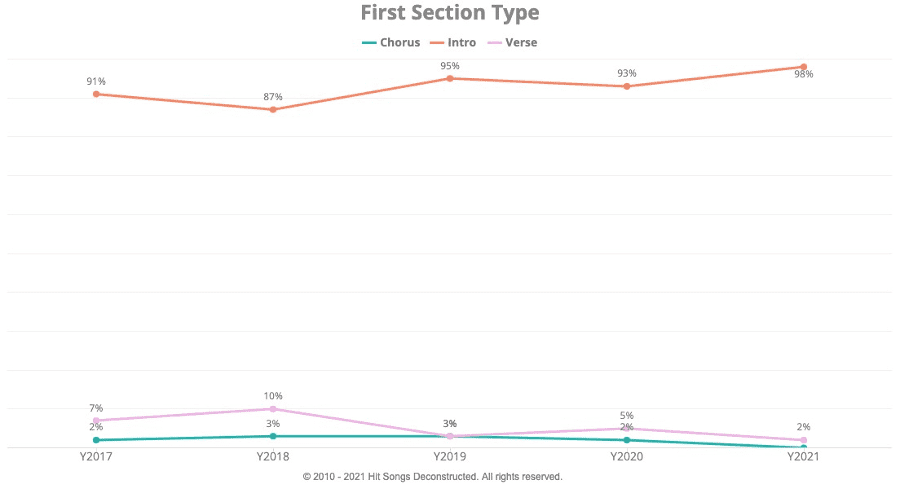

Omission of a “D” Section
Another area where abcdefu notably goes against the grain is by omitting a bridge or bridge surrogate “D” (departure) section, which has historically been very popular among non-hip hop Top 10 hits (81%-87% of songs over the past five years). However, there is arguably enough variety throughout the song to effectively keep the listener engaged from start to finish, and by omitting the “D” section it keeps the song on the shorter end of the spectrum.
Use Of A “D” Section in Non-Hip Hop Hot 100 Top 10 Hits: 2017-2021
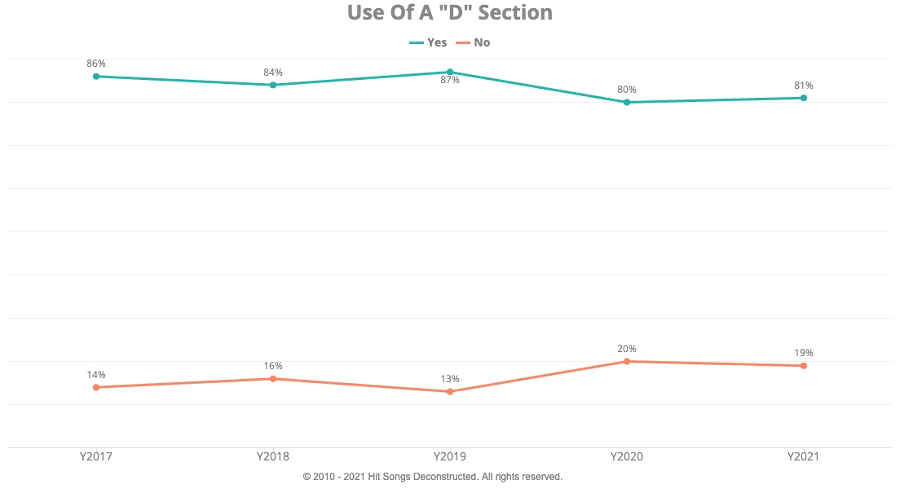

abcdefu kicks off with the chorus followed by two verse – pre-chorus – chorus – vocal break sectional progressions. Its like-sections (i.e., verse 1 and verse 2) possess a balance of similarities and differences that keep things cohesive yet interesting as the song progresses. Following these two sectional progressions, a final chorus bookends the song on a fresh but familiar note.
abcdefu
Non-Hip Hop Hot 100 Top 10 (2021)
*Data excludes Taylor Swift’s 10-minute long All Too Well (Taylor’s Version)
Save for abcdefu’s first verse, which has its arrival time on par with the Top 10 average, the time and percent into the song when its core sections occur is notably different. This is due in part to the song kicking off with the chorus, the omission of a “D” section, and its atypically long 32 second first verse, all of which alter its structural ordering from the norm.
Song Length
abcdefu clocks in at 2:47. While this is notably shorter than the 2021 Top 10 average of 3:18, it is in-line with the rise in songs landing under the three-minute mark, which edged-out the 3:00-3:29 range to become most popular in 2021.
Its short length is due in part to the omission of common song sections, like an intro, “D” section and outro, and its shorter-than-typical section lengths.
Song Length Ranges of Non-Hip Hop Hot 100 Top 10 Hits: 2017 – 2021
Section Length
Section lengths in abcdefu are both typical and atypical of non-hip hop Top 10 hits. On the typical side are its pre-chorus and second vocal break post-chorus, which are right in-line with 2021 averages. However, its choruses are seven-seconds shorter; its first vocal break is half the length of the second, functioning more as a “tease” than a fully developed section; and its two verses are both notably longer and shorter than the 27 second average, landing at 32 seconds and 16 seconds, respectively.
*Note that numbers may be rounded, resulting in slightly more or less than 100% of the song’s total composition
As is commonly the case with non-hip hop hits, abcdefu allocates the most time to the chorus, comprising 38% of its total composition. The verse follows at 29%, and the pre-chorus and vocal break round things out at 19% and 14% respectively.
Compared to the 2021 non-hip hop Hot 100 Top 10 average, abcdefu allocates more time to the pre-chorus and chorus, and essentially equal amounts of time to the verse and vocal break.
abcdefu / 2021 Hot 100 Top 10 Average Time Allocation
- Verse: 29% / 30%
- Pre-Chorus: 19% / 15%
- Chorus: 38% / 35%
- Vocal Break: 14% / 14%
Tempo
abcdefu sits at 61 BPM, 35 BPM slower than the 2021 non-hip hop Top 10 average of 96 BPM. The 60-69 BPM range was the fifth most popular tempo range of 2021, bouncing back after a drop in popularity in 2020. Some of the songs that fell into this tempo range in 2021 include Good Days, Need To Know, Wasted On You and Your Power, among others.
Tempo Range in Non-Hip Hop Hot 100 Top 10 Hits: 2017 – 2021 (Top 5)
Key
abcdefu is in the key of E major. While major keys have been most popular among non-hip hop Hot 100 Top 10 hits since 2019, they’ve been steadily declining and were neck-and-neck with minor keys in 2021.
Major vs. Minor Keys in Non-Hip Hop Hot 100 Top 10 Hits: 2017 – 2021
abcdefu progresses through two energy level “waves.” Each flows from low to high, with peaks in the vocal break post-choruses, save for the lower energy “wind down” fourth chorus at the end. It features an effective combination of gradual and pronounced energy shifts, complimenting loudness shifts, tradeoffs between power and momentum, and impactful S.I.A.s (section impact accentuators), all of which come together to create an engaging listening experience that keeps the listener locked in from start to finish.
Key
Wave: Indicates cross-sectional energy level flow from low to high
S.I.A. (Section Impact Accentuator): A transitional technique that heightens engagement through an accompaniment pull (full or partial), effect (riser, downlifter, etc.) and/or fill
abcdefu features an effective balance of both gradual and dynamic loudness shifts that closely mirror its energy flow. The most notable leaps occur leading into choruses 2 and 4, the first helping to maximize the chorus 2 high-energy payoff, and the second aiding in the chorus 4 wind-down at the end of the song.
Note that all LUFS levels in the song are fairly in line with the industry standard of a mastered mainstream hit.
Chorus 1 (B1)
Chorus 1 features the second-lowest overall energy in the entire song, providing room for growth in subsequent sections. It’s comprised of GAYLE’s mainly solo sung vocal and sixteenth-note driven electric guitar, the latter providing a subtle sense of forward motion in lieu of drums and bass.
At the end of the chorus, there is one – albeit relatively subtle – burst of energy, put into effect by the tension-heightening riser/downlifter sound effects, along with the shouted group delivery of the definitive “f**k off” lyric. Together, these energy-heightening elements bolster engagement leading into the ensuing verse.
Verse 1 (A1)
Verse 1 notably kicks up the song’s energy over the preceding chorus. The addition of drums, along with GAYLE’s rhythmic vocal delivery, locks the listener into a simmering groove, while the addition of low-octave guitar and bass provide low-end power that was missing from the chorus.
Pre-Chorus 1 (PC1)
The notably changed-up pre-chorus results in a slight decrease in energy compared to the preceding verse. However, this variation is minimal due to the tradeoff in energy-affecting qualities – namely power vs. momentum. While the omission of the verse’s sub-bass and electric guitar thin out the sound, the vibrant acoustic guitar strumming along with the eighth-note kick pattern create a heightened degree of momentum. This is bolstered by GAYLE’s higher-range and more animated vocal delivery, which further heightens excitement and anticipation leading into the ensuing chorus.
The pre-chorus ends with all the elements abruptly pulled from the mix. In their place, the tension-heightening riser/downlifter transitional effect returns, along with high-energy gang vocals that accentuate the song title hook and set up the ensuing chorus for maximum impact.
Chorus 2 (B2)
Chorus 2 notably kicks up the song’s energy right from the start. This is due in part to the more dense and powerful instrumental arrangement, and the addition of shouted gang vocals that double GAYLE’s lead. Together, along with the notable jump in loudness from -10.5 to -7 LUFS, they provide the listener with the song’s first high-energy “payoff,” framing the chorus lyrics in a new, angrier and more powerful context compared to the first time around.
Vocal Break 1 (VB1)
With the core arrangement of the chorus remaining in effect, the vocal break post-chorus kicks energy up another notch through the incorporation of the sixteenth-note-driven palm-muted distorted electric guitar from the verse and the newly added driving hi hat. Together, along with the shouted/sung-hybrid vocal hooks, they take abcdefu’s energy to its first peak.
At the end of the vocal break, a one-beat partial accompaniment pull S.I.A. is implemented, providing subtle separation between the energetic vocal break post-chorus and verse arrangements. This in turn bolsters the arrival of the verse 2 groove while accentuating the “f-u” of the song title hook.
Verse 2 (A2) Bars 1-2
Following the energy peak in the vocal break post-chorus, abcdefu’s energy is brought back down in the ensuing verse through a more intimate lead vocal and the omission of the distorted melodic guitar and driving open hi hats. However, while the decrease in loudness from -7.5 to -10.5 is quite pronounced, the overall cross-section energy reduction is fairly minimal, considering its more developed, driving qualities compared to its verse 1 counterpart. Most notable is the addition of closed hi-hat, which provides the section with increased drive, and the brighter, more reverberant snare, which results in a bigger sound (reference the Music & Instruments section of the report for details).
Toward the end of bar 2, the first of abcdefu’s two full accompaniment pull S.I.A.s is implemented for 1.5 beats. This heightens engagement through a brief break in momentum that highlights the lyric “you couldn’t take it.”
Pre-Chorus 2 (PC2)
In contrast to pre-chorus 1, the first-half of pre-chorus 2 maintains much of the accompaniment from the verse. This, along with the addition of momentum-driving elements such as the vibrantly strummed acoustic guitar and melodic electric guitar, and the omission of power elements like the sub-bass, results in a fairly even energy tradeoff between sections.
However, this all changes in the second half of the section, when the pre-chorus reverts to the more thinned-out qualities of its pre-chorus 1 counterpart. In addition to providing arrangement contrast against the ensuing chorus, it also provides a necessary energy contrast to help bolster its impact.
At the end of the second pre-chorus, the downlifter and riser effects are once again employed, creating a familiar S.I.A. leading into chorus 3. However, this S.I.A. does not feature an accompaniment pull, instead maintaining the pre-chorus arrangement along with a sped-up kick to further heighten momentum leading into the chorus.
Chorus 3 (B3)
Like it’s chorus 2 counterpart, chorus 3 provides a notable leap in energy over the pre-chorus due to its dense and powerful arrangement. However, its energy is a touch higher this time around due to the inclusion of additional gang vocal layers, guitar, bass and hats.
Vocal Break 2 (VB2)
Vocal break 2 takes abcdefu’s energy and loudness to its grand peak. This is due to the inclusion of louder gang vocals and offbeat guitar accents on top of the high-energy chorus 3 accompaniment.
Chorus 4 (B4)
Following the climactic vocal break post-chorus, the final chorus of abcdefu does a full 180 and drops energy to its lowest level in the song. This is due in part to its stripped back instrumental arrangement – consisting solely of a chorused/filtered melodic guitar pattern – and GAYLE’s more reserved delivery, omitting the high-energy gang vocal accompaniment. Complimenting this is a drastic reduction in loudness, leaping from -6 in the vocal break (the loudest in the song) to -15.5 (the lowest in the song). This bookends the song on a familiar note, energetically concluding it similar to chorus 1.
This full accompaniment pull S.I.A. pulls the guitar from the mix, leaving only GAYLE’s final rendition of the final “you can all f**k off” lyric lingering in the listener’s head at the conclusion of the song.
abcdefu is a rock song with a combination of pop, punk and alt/indie influences.
Key
X: The influence appears prominently within the stanza and/or section
x: The influence appears minimally within the stanza and/or section
abcdefu’s primary genre is rock, which is prominent throughout the entire song. While it possesses both notable rock and pop qualities, it leans more toward the rock end of the spectrum due in part to its prominent use of distorted electric guitar and a rock-oriented progression, GAYLE’s combination of snarling and exasperated vocal deliveries, and scathing lyrics to boot.
abcdefu’s pop influence is due to its notable mainstream-friendly qualities including its K.I.S.S. ME (keep it simple, singable, and memorable) melodies, infectious vocal hooks, easy-to-follow-structure, relatable lyrical theme, and instrumentation such as electronic drums and riser/downlifter transitional effects.
While not as punk as more traditional, up-tempo punk songs by the likes of The Sex Pistols, The Clash and The Ramones, abcdefu does have a notable underlying punk attitude. This is due to the combination of the rawness of the electric guitar timbre and its accompanying pattern, the snarling and exasperated vocals, and the profanity-laced lyrics.
abcdefu features a minimal alt/indie influence that’s present from the second chorus through the end of the song. It’s put into effect exclusively by some of the guitars, including the alternating melodic pattern heard in the choruses and vocal break post-choruses, and the reverb-drenched guitar accents heard in the second verse and second vocal break post-chorus.
abcdefu’s expert fusion of rock, pop, punk and alt/indie influences enabled it to effectively blend in and stand out in today’s mainstream music scene.
On the familiar side is its notable pop influence, which not surprisingly was present in all songs in 2021 and in years prior. While rock as a primary genre has been scarce, as an influence it was notably more popular, present in one-third of non-hip hop Hot 100 Top 10 hits in 2021. Among the diverse group of Top 10s that feature a rock influence in varying degrees of prominence are Glass Animals’ Heat Waves, Gabby Barrett’s I Hope, 24K Goldn and iann dior’s Mood, and perhaps most notably, Olivia Rodrigo’s Good 4 U.
And speaking of Good 4 U, both songs also share the commonality of the far less popular alt/indie and punk influences. Alt/indie has generally hovered around 13% of songs on average over the past five years, and punk has generally been non-existent. In addition to shaping abcdefu’s sound and vibe, these influences also helped it stand out among its mainstream contemporaries, while the more popular pop and rock influences enabled it to sound familiar and more easily connect.
Rock as a Primary Genre in the Hot 100 Top 10: 2017 – 2021
Influences in the Hot 100 Top 10: 2017 – 2021 (Outside the Hip Hop/Rap Primary Genre)
abcdefu features an expertly crafted instrumental arrangement that achieves a lot in its short runtime. At its heart is a strategic assortment of mix elements including electronic and acoustic drums and percussion, electric and acoustic guitars, electric and synth basses, keys, and a host of effects. Together, along with their varying timbres, textures and patterns, they create an engaging sound pallet that is rooted in “traditional” guitar-driven rock while simultaneously appealing to a modern pop audience.
But perhaps most notable is the methodical manner in that the arrangement unfolds over the course of the song. In addition to creating an effective balance of engagement and familiarity across sections, which is the hallmark of a strong arrangement, the manner in that it supports the vocals and lyrics to create effective prosody and heighten the listener’s emotional connection with the song is its true brilliance.
From the solo guitar bookending chorus arrangements that support GAYLE’s subdued delivery of the scathing lyrics, to the dense, high-energy mid-song chorus payoffs that put the chorus lyrics in a new angrier context along with the shouted gang vocals, to the timbral thinning of the acoustic guitar-driven pre-chorus 1 arrangement that effectively sets up the ensuing chorus along with the higher-register vocals, these accompaniment shifts provide abcdefu with heightened emotional dimension that deepens the listener’s connection with the song, and the artist.
*Click image to enlarge
Main Electric Guitar 1
The main electric guitar used in abcdefu is introduced in the first chorus and then returns in every section save for pre-chorus 1 and choruses 2 and 4. It plays a palm-muted sixteenth-note pattern, is double tracked with hard left and right panning, and is treated with distortion, providing the song with its raw rock grit.
Main Electric Guitar 2 (Octave Double)
This guitar is processed similarly to the main electric guitar and plays the same pattern, albeit an octave below. It is featured in the same sections as the main electric guitar save for the first chorus, providing additional low-end texture and density to the mix.
Melodic Electric Guitar 1 (Distorted)
This distorted electric guitar plays a unique sixteenth-note alternating melodic pattern exclusively in choruses 2 and 3 and in their ensuing vocal breaks. Double tracked and panned hard left and right to surround the listener, its inclusion both heightens interest and forward motion, helping the song’s main “hook centers” to further stand out and connect against the surrounding sections.
Melodic Electric Guitar 2 (Chorused/Filtered)
This guitar plays the same pattern as melodic electric guitar 1, albeit with less distortion and the addition of a chorus/filtering effect. It provides a unique texture to the last four sections of the song starting in pre-chorus 2 and is heard most audibly in chorus 4 due to the sparseness of the arrangement.
Muted Electric Guitar
Despite being underneath the thick guitar layers, the subtle plucking of the muted guitar adds an extra attack to the guitar rhythms in vocal break 1.
Electric Guitar Accents
Compared to the other electric guitars in the song, this one is notably cleaner, higher-voiced and processed with copious reverb and delay. It adds stabs on the off-beats, providing a unique rhythmic quality and texture to the second half of verse 2 through the first half of pre-chorus 2 and the entirety of vocal break 2.
Acoustic Guitar
Acoustic guitar is featured solely in the pre-choruses. Its lighter, brighter texture provides engaging contrast against the surrounding sections, helping the denser and more energetic choruses to further stand out and connect. It features slight high-pass filtering to enhance the lighter texture, and is double tracked and panned hard left and right.
Vintage Synth
This synth possesses a distinct vintage quality with its low-passed timbre and warbling tape emulator sound. It provides unique harmonic support in all sections save for choruses 1, 2 and 4 and the first stanza of verse 1.
Piano (Acoustic)
Acoustic piano appears in the third chorus and subsequent vocal break, providing high-pitched melodic accents to the dense arrangement. While it is featured fairly low in the mix, it cuts through with its panning and subtle grittiness, due in part to some saturation processing.
Electric Bass
The electric bass is initially heard in the first verse, and is present in all subsequent sections, save for choruses 2 and 4 and vocal break 1. It provides a sixteenth-note pulse treated with slight distortion that allows it to stand out from the other low-end layers, while also blending with the main electric guitar.
Synth Sub-Bass
The synth sub-bass initially appears sustaining underneath the electric bass in verse 1, and is present in every subsequent section, save for the pre-choruses and chorus 4. It adds an additional layer that fills out and thickens the low end of the arrangement.
Synth Fuzz Bass
The synth fuzz bass is heard in choruses 2 and 3 and the subsequent vocal breaks. It heightens the low end with a gritty texture, keeping the song rooted in a dark tonality and adding more emphasis to these hook-based sections.
Kick 1 (Electronic)
Kick 1 is a thick electronic sample, making its first appearance in verse 1 and remaining in effect until chorus 4. It performs a busy pattern that drives the rhythmic motion of the song, with a strong attack and ample compression that allows it to cut through the mix.
Tight Snare (Electronic)
Heard exclusively in the first verse, the tight snare solidifies the backbeat with a dry, thick distorted timbre that is layered with the bright claps to further bolster the attack and provide punch to the mix.
Tight Reverberant Snare (Electronic)
Directly related to the tight snare, the tight reverberant snare is the same sample but processed with copious reverb, beginning in the second verse and heard through the first half of pre-chorus 2. The additional reverb enhances the density and energy of the section, while providing a cohesive thread between the two snare tones.
Large Reverberant Snare (Electronic)
The large reverberant snare is present in choruses 2 and 3 and the ensuing vocal breaks. Drenched in reverb, it provides these “hook centers” with a bigger, more epic sound that helps to bolster their impact.
Thin Snare (Electronic)
This thin, dry snare adds slight rhythmic variation to the second chorus and first vocal break.
Reversed Snare (Electronic)
Acting as a short riser, the reversed snare heightens engagement leading into the third chorus.
Claps 1 (Filtered-Electronic)
Featured solely in the first pre-chorus, the filtered claps replace the snare of the preceding verse to help heighten cross-section engagement leading into the ensuing chorus.
Claps 2 (Bright-Electronic)
The unfiltered version of claps 1, these brighter, more piercing claps are layered with the tight snare and tight reverberant snare, and are prominently featured in the second half of pre-chorus 2.
Open Hi Hat (Acoustic)
The open hi hat adds an acoustic texture that accentuates the song’s rock feel with a driving rhythm on the off-beats in the vocal breaks and third chorus.
Closed Hi Hat (Electronic)
This hi hat possesses a thin, gritty tone that enhances the kick drum pattern in the second and third choruses and the ensuing vocal breaks.
Closed Hi Hat (Acoustic)
Similar to the open hi hat, this closed hi hat provides an acoustic texture with a sixteenth-note driving rhythm. It is present from the second verse through the first half of the second pre-chorus, and returns in the third chorus and second vocal break.
Reversed Hi Hat (Acoustic)
This reversed version of the closed acoustic hi hat functions as a transitional element leading most notably into the second pre-chorus as well as the second vocal break post-chorus.
Crash Cymbal (Acoustic)
The crash cymbal bolsters the arrival of choruses 2 and 3 and vocal breaks 1 and 2 with a bright, piercing impact.
Shaker (Electronic)
Pitch and formant-shifted down, the shaker provides an underlying rustle effect that enhances the gritty nature of the song in the second verse and first half of the second pre-chorus.
Downlifter
The downlifter is a distorted triangle wave that is gradually pitch shifted down to heighten engagement between sections.
Digital Riser
Paired with the downlifter, the riser is constructed similarly, pitch shifting upwards to create a rising effect. With an infusion of white noise and distortion, the two combine to heighten engagement and interest between sections.
Synth Impact SFX
Drenched in reverb, this bright synth with a “woo”-type characteristic enhances the impact of the downbeat of choruses 2 and 3, vocal break 1 and verse 2.
Reversed SFX
This sound effect is a bright synth texture used as a transitional riser leading into the first pre-chorus.
Click SFX
This high-pitched, percussive sample subtly bolsters the full accompaniment pull S.I.A. (section impact accentuator) and exposed vocal in the second verse.
Chordal Riser
The chordal riser provides engaging harmonic support coming out of the accompaniment pull in verse 2 and leading into pre-chorus 2. Created by reversing a synth pad, it is treated with a copious amount of reverb that adds a touch of depth to contrast from the many dry, front-and-center textures of the song.
Chordal Impact
Complementing the chordal riser, the chordal impact is a reverb-drenched synth that accentuates the second half of verse 2 and the second pre-chorus.
Music & Instruments: Section By Section
*Note that this chord progression is repeated throughout the song. For additional details reference the Harmonic Progressions section of the report.
Chorus 1 kicks abcdefu off in a sparse manner, with a palm-muted, sixteenth-note-driven distorted electric guitar providing the sole accompaniment to GAYLE’s lead. While minimal, this arrangement achieves a few key things:
- The raw, distorted timbre of the guitar along with its pattern establishes the song’s gritty rock vibe.
- The consistent sixteenth-note rhythm puts the song into motion.
- The sparseness of the arrangement provides room for the song to build both on a cross-section and like-section basis. Additionally, it creates an intimate vibe that perfectly compliments GAYLE’s subdued/moody delivery of the scathing lyrics. This creates strong prosody, effectively heightening the listener’s emotional connection with the song right from the start.
In the last bar of the section, downlifter and riser sound effects are added to the mix, followed by a brief kick pattern at the end. Together, they create an engaging S.I.A. (section impact accentuator) that bolsters the transition into the ensuing verse; calls attention to the “you can all f-off” lyrical summation; and offsets the more “classic/traditional” guitar-driven rock vibe with a modern pop quality, which sets the tone for the entire song.
Chorus 1 Arrangement: At-A-Glance
Stanza 1
With the guitar from the preceding chorus remaining in effect to provide cross-section continuity, the first stanza of the verse builds the arrangement through the introduction of kick, snare, claps, two basses and an additional electric guitar. Together, they achieve the following:
- They lock the listener into the fully established sparse, dark and simmering groove, which perfectly complements GAYLE’s continued subdued/moody delivery of the troublesome lyrics.
- The basses and lower-octave guitar fill out the low-end of the frequency spectrum, while the snare, claps and guitar fill out the mid-range. However, there is still no overt high-frequency information in the mix, leaving room for the song to grow from a frequency standpoint.
- The modern qualities of the electronic kick and snare balance out the more “traditional” rock guitar, further bolstering the song’s relevancy in today’s mainstream marketplace.
Stanza 2
With the core arrangement of stanza 1 remaining in effect to provide continuity, stanza 2 adds a vintage-sounding synth into the mix. While subtle, the additional color, texture and harmonic support it provides is important in heightening interest in the otherwise instrumentally and vocally repetitive section.
Verse 1 Instrumental Arrangement: At-A-Glance
Following the cohesive instrumental arrangement build across the chorus and both stanzas of the verse, the pre-chorus notably changes things up through the density, sound pallet, energy/momentum and frequency contrast it provides. Along with the higher-range delivery of the “I’m over this” lyrics, this shift in instrumental arrangement heightens the listener’s engagement leading toward the chorus, bolstering its impact in the process while providing separation between sections of similar accompaniment and feel.
Bars 1-3
With the guitar-driven chord progression and vintage synth providing cross-section continuity, the following elements are notably changed up in the pre-chorus:
- The electric guitars are pulled from the mix and replaced with acoustic guitar. This provides the pre-chorus with a comparatively thinner sound along with high-end frequency information that was lacking in the preceding sections. Additionally, the more vibrant strumming pattern serves to further heighten interest and momentum leading toward the chorus while maintaining the familiar chord progression.
- The piercing snare/clap combination from the verse is replaced with a more subdued filtered clap on beats 2 and 4, reducing the punch of the backbeat.
- The sub-bass is pulled from the mix, further thinning out the low end of the arrangement.
- The kick is low-pass filtered and featured at a lower level in the mix, resulting in a more “muffled” timbre that results in less low-end. However, it is now playing a more driving eighth-note pattern, which provides the pre-chorus with a heightened degree of forward motion leading toward the chorus.
Bar 4
In the last bar of the pre-chorus, all the elements are abruptly pulled from the mix. In their place, the downlifter and riser effects that were initially featured in the transition between chorus 1 and verse 1 return, though this time with the riser being more pronounced. Together, they form a highly engaging S.I.A. that calls attention to the first iteration of the song-defining “A-B-C-D-E-F-U” hook while setting up the powerful ensuing chorus for maximum impact.
Pre-Chorus 1 Instrumental Arrangement: At-A-Glance
Following the thinned-out, acoustic guitar-driven pre-chorus and engagement-heightening S.I.A., the second chorus hits with the densest, most powerful arrangement heard thus far in the song. In addition to providing the listener with an impactful high-energy “payoff,” this instrumental arrangement, along with the newly added sung/shouted gang vocals, provides chorus 2 with a new, angrier emotional context compared to the first time around.
Stanza 1
The chorus hits hard right out of the gate with a prominent kick, crash and synth impact sound effect marking its arrival on beat 1. This is followed by what is essentially a more developed version of the verse arrangement, taking the song’s intensity to a peak in both a familiar and fresh manner.
In terms of the drum/bass groove, while its similar to the verse, there are some notable differences to take note of:
- The kick is doubled by the hat, which accentuates its attack and enables it to further cut through the mix. In terms of its pattern, it is simpler than the verse, which is warranted to help prevent things from becoming overly busy. It sounds exclusively on beats 1 and 3 save for the “and” of beat 4, where it subtly heightens interest leading into the second stanza while punctuating the definitive “f**k you” lyric.
- The snare, in contrast to the verse, is fuller and processed with copious reverb, which amplifies its presence and contributes to the chorus’s “big” sound. In addition, a subtle thin snare embellishment is heard on the “and” of beat 2, subtly heightening interest in the otherwise instrumentally repetitive section.
- In addition to the drum and bass groove, the most notable instrumental changeup compared to the verse is the guitar. Here, in lieu of the palm-muted electric guitar, a distorted guitar playing an alternating two-pitch sixteenth-note pattern is featured. In addition to heightening interest and excitement, the qualities of this guitar provide the song with a more notable alt/indie vibe, reminiscent of the Pixies, for instance.
Stanza 2
The second stanza features essentially the same instrumental arrangement as the first, allowing the listener’s full attention to be on the vocals without distraction. The sole variation is a snare fill in the third bar, which subtly heightens interest.
Chorus 2 Instrumental Arrangement: At-A-Glance
The vocal break post-chorus begins in a similar manner as the preceding chorus, with a kick/crash punctuating its arrival on beat 1. However, this time there isn’t an accompaniment pull/downlifter/riser S.I.A. associated with it, which keeps the listener locked into the high-energy groove without missing a beat.
The balance of the section maintains the chorus’s high-energy arrangement, which provides cross-section continuity and allows the listener’s full attention to be on the two vocal hooks without distraction. However, to subtly heighten interest and take the song’s intensity to its first peak, a driving open hi-hat is added to the mix for the first time along with the reintroduction of the palm muted electric guitar, its octave double, and vintage synth from the verse. Note that the inclusion of these verse elements serves to make the song as a whole more cohesive and familiar as well.
At the end of the vocal break, a one-beat partial accompaniment pull S.I.A. is implemented. While subtle, it achieves a few key things:
- It provides separation between the energetic vocal break post-chorus 1 and verse 2 arrangements.
- It bolsters the arrival of the familiar verse 2 groove.
- It highlights the “f” in the abcdefu hook, followed by the “u” hitting on beat one of the ensuing verse.
Vocal Break 1 Instrumental Arrangement: At-A-Glance
Verse 2 is half the length of verse 1, clocking in at four bars. As is typically the case with non-hip hop hit verses, verse 2 develops off of the first verse while decreasing the density and energy following the chorus and vocal break post-chorus, leaving room for growth in subsequent sections. Together, these qualities serve to heighten interest while maintaining familiarity in the scope of the song.
Bars 1-2
The first half of verse 2 builds on the more developed verse 1, stanza 2 arrangement with the following additions and changeups:
- The snare now features a notable reverb tail, which was not present in verse 1. This provides verse 2 with a new interest-heightening higher-frequency texture that also contributes to its bigger feel. However, note that the reverb isn’t as pronounced as the preceding chorus and vocal break post-chorus, which contributes to the cross-section contrast.
- A new closed hi-hat playing a sixteenth-note pattern provides more forward motion along with additional high frequency information.
- A low-level, saturated and low-pass filtered shaker adds a darker, rustling texture to the back of the mix.
The last beat of bar 2 features the only in-section S.I.A. in the song. Consisting of a full accompaniment pull, this achieves a few key things, including:
- Creating a jarring/surprise moment midway through the section.
- Highlighting the “you couldn’t take it” lyric.
- Preventing the continuous groove from becoming overly redundant while setting up its return in the second stanza.
- Providing like-section contrast against verse 1, which doesn’t contain an in-section S.I.A.
Bars 3-4
Following the S.I.A., the listener is locked back into the core groove of the first stanza. However, to help subtly heighten both interest and energy, an additional guitar, which is cleaner and more reverberant than the other guitars heard thus far in the song, plays off-beat accents.
Verse 2 Instrumental Arrangement: At-A-Glance
In contrast to pre-chorus 1, pre-chorus 2 features a notable changeup in the instrumental arrangement, building off of verse 2 for two bars before returning to more familiar territory with the expected timbral shift that is reminiscent of pre-chorus 1.
Bars 1-2
The first half of the pre-chorus keeps the kick, snare, claps, closed hat, shaker, vintage synth, electric bass and electric guitars from the preceding verse in effect, which provides cross-section continuity. However, it also omits certain elements while reintroducing others, serving to heighten both interest and familiarity in the scope of the song:
- The acoustic guitar from pre-chorus 1 returns, providing like-section familiarity.
- A new chorused/filtered electric guitar plays the same melodic pattern as the melodic electric guitar 1 in chorus 2.
- The sub-bass from the verse is omitted from the mix, subtly reducing the pre-chorus’ bottom-end power.
Bars 3-4
Following a reversed hi hat at the end of bar 2, which subtly heightens interest leading into the second-half of the section, the pre-chorus arrangement notably thins in timbre and features more high frequency information, which is a commonality shared with its first occurrence counterpart and creates additional like-section familiarity. And again, this changeup serves to heighten engagement leading into the ensuing chorus and bolster its impact:
- The kick shifts to a more muffled timbre and eighth-note pattern, a commonality shared with pre-chorus 1.
- Claps replace the snare, another commonality shared with pre-chorus 1. However, this time around the claps are unfiltered, which makes them more pronounced in the mix and contributes to the overall higher-energy at this point in the song.
- The hats and shaker are omitted, the former most notably resulting in less high-end frequency information.
- The cleaner, reverberant off-beat electric guitar stabs are pulled from the mix.
At the end of the section, downlifter and riser effects are once again employed, creating a familiar S.I.A. leading into chorus 3. However, in contrast to the first time around, here the acoustic guitar remains in the mix, which along with the faster-paced kick provides heightened momentum leading into the chorus while providing subtle, like-S.I.A. variation, which helps to prevent things from becoming too predictable.
Pre-Chorus 2 Instrumental Arrangement: At-A-Glance
Chorus 3 subtly builds on the dense, high-energy vocal break post-chorus 2 arrangement. It adds additional guitar, electric bass, hats, and the new low-level acoustic piano to the mix, which takes density and energy to a near grand peak.
Chorus 3 Instrumental Arrangement: At-A-Glance
Twice the length of vocal break post-chorus 1, vocal break post-chorus 2 maintains the chorus 3 arrangement to provide cross-section continuity, while adding in the electric guitar accents that had previously been featured in verse 2 and pre-chorus 2. While subtle, its addition creates the densest and most energetic arrangement in the entire song, taking the listener’s excitement to a grand apex.
Vocal Break 2 Instrumental Arrangement: At-A-Glance
Following the highly dense and energetic chorus 3 and ensuing vocal break post-chorus, chorus 4 does a complete 180 by stripping back the arrangement to just the chorused/filtered melodic electric guitar and GAYLE’s comparatively subdued vocals. This changeup bookends the song on a familiar note, putting this guitar pattern front and center to keep things interesting while winding the song down to an acapella conclusion.
Chorus 4 Instrumental Arrangement: At-A-Glance
abcdefu features one chord progression that is kept interesting through a variety of delivery styles throughout the song.
E5 – G#5 – C#5 – A5
E – G# – C#m – A
E – G# – C#m – A
E – G# – C#m – A
E – G#5 – C#m – A5
abcdefu’s sole chord progression is rooted in the key of E major, following a I – V/vi – vi – IV pattern. This is a slight variation on the highly popular I – V – vi – IV progression heard in an array of pop and rock hits over the years such as Girls Like You (Maroon 5), Cruise (Florida Georgia Line), Demons (Imagine Dragons), The Edge Of Glory (Lady Gaga), and F**kn’ Perfect (P!nk), to name a few.
In abcdefu, the notable use of V/vi instead of the expected V chord subverts listener expectations with a highly engaging non-diatonic chord. As a result, the progression follows a tonic – secondary dominant – tonic – subdominant pattern, creating moments of tension and release due to the unique secondary dominant chord.
Keeping this repetitive chord progression interesting throughout the song are a host of delivery variations, including palm-muted 16th-note distorted electric guitar power chords, vibrantly strummed acoustic guitar, alternating pitch melodies, and a vintage-sounding synth. These varying deliveries combined with the alternating use of power chords and triads keep the engaging harmonic motion interesting while contributing to the evolving nature of the instrumental arrangement.
abcdefu features a solo female lead vocal from GAYLE. Generally hovering between one-quarter and one-third of non-hip hop Hot 100 Top 10 hits over the past five years, solo female leads have been trading off with solo male leads for top billing up until 2021, when they tied and slightly trailed all-male duet/group vocals.
Lead Vocal Gender in Hot 100 Top 10 (Non-Hip Hop Hits): 2017 – 2021
abcdefu features an exclusively sung lead vocal delivery. Not surprisingly, non-hip hop Hot 100 Top 10 hits that feature exclusively sung lead vocals have by far been the most popular over the past five years and beyond, with 70% of songs in 2021.
Lead Vocal Delivery in Hot 100 Top 10 (Non-Hip Hop Hits): 2017 – 2021
In addition to the lead, abcdefu features a host of background vocals including harmonies, unison doubles, sung adlibs, and shouted gang vocals.
abcdefu features minimal vocal effects and processing, including reverb, delay and autotune, all of which maintain an intimate vibe while adhering to mainstream vocal production standards.
Lead: Female (GAYLE): GAYLE’s lead vocal
BGV 1: Female (Unison Double): Background vocal doubles in unison with the lead
BGV 2: Female (Lead Harmony): Background vocal that harmonizes with the lead on different pitches
BGV 3: Female (Lead Gang Vocals): Background vocals that are tracked many times to create a large “crowd” effect
BGV 4: Female (Independent Backgrounds): Background vocals featured independently from the lead
BGV 5: Female (Independent GAYLE): Lead vocals that are independent embellishments
Key
BGV: Background vocals
S: Sung
SH: Shouted
/: Separates stanzas in sections where a certain vocal type occurs in only one stanza
Key
Header Markings
LEAD: FEMALE: GAYLE’s lead vocal
BGV 1: LEAD UNISON DOUBLE: Lead vocal doubles in unison
BGV 2: LEAD HARM: Background vocal that harmonize with the lead on different pitches
BGV 3: LEAD GANG: Background vocals that are tracked many times to create a large “crowd” effect
BGV 4: IND BGVs: Background vocals featured independently from the lead
BGV 5: IND GAYLE: Lead vocals that are independent embellishments
Vocal Delivery Markings
S: Sung
SH: Shouted
Color-Coded Lyrics: Denotes lyrics sung with harmonies on the lead (green) and independent of the lead (orange). Note that this matches the color-coding of the above vocal arrangement overview table.
Chorus 1 features a solo vocal from GAYLE save for the addition of gang vocals that punctuate the final two words. Her voice is panned up the middle and is kept on the natural side, devoid of any layering and notable processing save for some moderate reverb and compression that helps her voice to blend in with the sparse guitar-driven accompaniment.
Keeping GAYLE’s vocal on the more natural side was a strategic, well warranted choice. It provides her subdued/moody delivery of the scathing lyrics with an intimate quality, allowing the listener to develop a deeper emotional connection with GAYLE, and the song, right from the start.
However, this all changes at the tail end of the section on the definitive closing lyric, “f**k off.” Delivered by a multi-voiced gang vocal and panned through the stereo field, this vocal shift serves a few key purposes, including heightening the impact of the definitive lyric, foreshadowing the gang vocal that accompanies GAYLE’s lead in choruses 2 and 3, and having the potential to serve as an A.P.M. (audience participation moment) in a live setting.
Verse 1 picks up where chorus 1 left off, continuing with GAYLE’s predominantly solo vocal, albeit with slightly less reverb to bring her natural-sounding voice to the front of the more developed arrangement.
However, to help heighten interest in this long, vocally and instrumentally stagnant section (twice the length of the next longest section), two instances of harmony are added to the mix, as well as two instances of a shouted background vocal, “Yeah.” The first harmony occurs midway through stanza 2, where multiple pitches harmonize with GAYLE on the lyric “what a connection.” However, the lower-level, reverb processing and hard left and right panning across the stereo field keeps GAYLE’s centered lead as the focal point while the background vocal provides a colorful embellishment.
The other background vocal comes at the tail end of the section and is featured independently of GAYLE’s lead. Here we have a simple, multi-layered, sustained “ah” traversing the stereo field at a relatively low level in the mix. In addition to serving as a colorful embellishment leading into the chorus, it also creates familiarity with another recent pop/punk anthem, Olivia Rodrigo’s Good 4 U, which similarly uses the technique throughout the song.
Pre-chorus 1 continues with GAYLE’s solo lead, maintaining the intimate quality that has been in effect throughout the preceding chorus and verse. However, here her voice is slightly enhanced due to parallel processing, a production technique that subtly mixes in a brighter, saturated version of her vocals underneath the lead. This provides her higher-register vocal with slightly more presence in the lighter, acoustic-guitar-driven arrangement and helps to call further attention to the chorus set-up lyrics.
Following three consecutive sections of generally solo, intimate vocals from GAYLE, chorus 2 provides a significant shift with the inclusion of sung lead unison doubles and shouted/sung hybrid gang vocals alongside GAYLE’s lead. However, note that GAYLE’s lead is still the focal point of the section, which provides cross-section continuity.
In addition to bolstering the chorus’ power and ability to stand out along with the denser instrumental arrangement, this vocal changeup also provides the song with heightened emotional dimension. While the first time around the scathing lyrics were delivered in a more intimate and subdued manner, here, after the lyrical developments in the verse and chorus, the more powerful vocals put the familiar lyrics in a well-warranted angrier context.
Vocal break post-chorus 1 follows suit with the preceding chorus, maintaining the same vocal qualities. This both provides cross-section continuity and helps to emphasize the dismissive vocal hooks in the dense mix.
Verse 2, which is half the length of verse 1, features essentially the same vocal qualities as the second stanza of verse 1. This both creates like-section familiarity with its verse 1 counterpart while heightening engagement against the stagnant gang vocal delivery of the preceding chorus and vocal break post-chorus sections.
Pre-chorus 2 follows suit with its pre-chorus 1 counterpart save for the addition of the lead-harmonizing vocals. While relatively low in the mix, the multi-pitch harmony provides the pre-chorus with additional color and texture in addition to the more pronounced changeup in accompaniment.
Chorus 3 features the same vocal qualities as chorus 2, which provides like-section familiarity in the scope of the song. The main differentiation stems from subtle development in the accompaniment and lyrical changeups on lines 3 and 4.
Vocal break post-chorus 2 is twice the length of its first occurrence counterpart and possesses both similarities and differences in the vocal production.
The main commonality between the two sections is GAYLE’s lead, which is paired with the gang vocals. However, to provide subtle like-section variation and further heighten excitement and energy at this point in the song, additional gang vocal layers are added to the mix. Furthermore, an independent GAYLE vocal is featured at the transition point between stanzas, subtly heightening interest while showcasing GAYLE’s vocal chops.
The fourth and final chorus reverts to the solo vocal that defined chorus 1, which bookends the song on a familiar note. However, there is notably less reverb, which creates the most intimate vocal delivery heard over the sparsest instrumental accompaniment. This provides new emotional dimension at the conclusion of the song, as opposed to the angrier deliveries that defined choruses 2 and 3. Additionally, the exposed nature of the ending further highlights GAYLE’s vocal chops with a unique, acapella melodic changeup.
abcdefu possesses all of the melodic qualities that one might expect to find in a major hit: adherence to the K.I.S.S. ME principle (keep it simple, singable and memorable), making use of highly common A.M.P. melodies (alternating melodic patterns), recycling melodies in both fresh and familiar ways in the vocal break post-chorus, striking an effective balance of repetition and contrast both within and across sections, and perfectly jibing with GAYLE’s vocal delivery to heighten the listener’s emotional connection with the lyrics.
However, the song also features unique qualities that set it apart from many of its mainstream contemporaries. One of the most notable is the chorus’s nursery rhyme-styled melody a la Rain, Rain Go Away, which delivers the scathing lyrics in a taunting manner that creates a sense of irony that the listener may, or may not, be aware of. Another is the atypical variations in bookending choruses, where the “A-B-C-D-E-F-U” hook is omitted the first time around and the melody is altered at the tail-end of the song. However, while atypical, these decisions were made with intent and purpose and serve the song perfectly.
Vocal Melody Graph Key
Y Axis: Pitches
X Axis: Song sections and melodic range
Lines: Depict melodic patterns with each dot representing a particular pitch
Graphs: Reflect lead vocals (excludes harmony)
Numbers in the Graphs: Depict the scale degree of each note
Curved Line: Slur across two or more pitches
Main melodic parts, such as upper-case A, B and C, reflect the main melodic structure of each line in a song section. Sub-melodic parts, such as lower-case a, b and c, reflect melodic structure both within and across lines.
The vocal melody part classifications in each section are specific to that particular section type (i.e. verses, pre-choruses, etc.) and do not relate to other section types. (i.e. part A classification in verse 1 does not relate to part A in the chorus, but part A in verse 1 does relate to part A in verse 2).
Vocal melody parts are determined by pitches, rhythms and melodic pattern commonalities.
Verse 1 spans an octave from G#3 to G#4 and is composed of two highly similar stanzas that follow an AAAB/AAAB main melodic structure. However, there are subtle differences between them that help to keep things interesting without sacrificing connectability and memorability. Verse 2 spans the same range as verse 1 and also follows an AAAB main melodic structure. However, it differs in that it only features one stanza and possesses additional subtle melodic differences.
On a cross-section basis, compared to the preceding choruses, the verses focus more on low register melodies, incorporate a greater degree of monotone deliveries, and have generally longer-length phrases. However, both share the commonality of A.M.P. melodies.
A.M.P.
A.M.P. is an acronym for alternating melodic pattern, where two pitches repeatedly alternate in a stepwise or intervallic manner. In the verse, the A.M.P. is featured subtly in the first three lines of each stanza, and more prominently in the last line. Below is an illustration of verse 1’s use of A.M.P.s, highlighted in red.
Verse 1 A.M.P.s
Verse 1 Melodic Direction: At-a-Glance
Verse 2 Melodic Direction: At-a-Glance
Verse 1 Melodic Part Structure: At-a-Glance
Verse 2 Melodic Part Structure: At-a-Glance



*Note the use of primes (i.e., b1′) to illustrate a nearly identical melodic sub part
*Note that all images and analysis shown below pertains to verse 1 unless otherwise noted. Differences between verses 1 and 2, if any, are detailed in each line grouping’s analysis.
Part a1: I swear I meant to mean the best
Part b1: When it end-ed
Line 1 is composed of main melodic part A/sub-parts a1 and b1. Part a1 consists of a driving sixteenth-note melody entirely centered on the tonic save for the 3-7 leap at the end, which provides an engaging splash of color. The rhythmic shift to an eighth note at the end serves to provide subtle segmentation leading into part b1, which predominantly alternates between the 7th and 6th scale degrees across a more varied rhythm. This effectively heightens tension while highlighting the lyrical crux of the line.
Verse 2 Variation
Line 1 of verse 2 varies slightly both rhythmically and melodically from verse 1. The most notable changeup is the placement of the 1-3 leap in sub part a, which is shifted to the “and” of beat 2. While subtle, this helps to heighten interest while maintaining a high degree of like-section familiarity.
Verse 1, Line 1
Verse 2, Line 1
*The blue boxes illustrate differences in verse 2 compared to verse 1
Part a1: E-ven tried to bite my tongue
Part b2: When you start sh*t
Line 2 is composed of sub parts a1 and b2. It is melodically identical to line 1 save for a couple of added slurs on the lyrics “tongue” and “start,” and ending with a descending 7-6-5-3 progression as opposed to 7-1-6. In addition to providing subtle variation against line 1, note that the more pronounced descent at the end perfectly jibes with and accentuates the impactful lyric, “when you start sh*t.”
Verse 2 Variation
Line 2 of verse 2 features a few minor variations compared to its verse 1 counterpart, again maintaining a high degree of familiarity while preventing like-section redundancy.
Verse 1, Line 2
Verse 2, Line 2
*The blue boxes illustrate differences in verse 2 compared to verse 1
Part a1: Now you’re text-in’ all my friends
Part b1: Ask-ing questions
Line 3 is identical to line 1 save for a few subtle rhythmic changeups that accommodate the new lyrics.
Verse 2 Variation
As is the case with preceding lines, line 3 of verse 2 varies slightly compared to its verse 1 counterpart.
Verse 1, Line 3
Verse 2, Line 3
*The blue boxes illustrate differences in verse 2 compared to verse 1
Part c: They nev-er e-ven liked you in the first place
Line 4 is composed of sub part c. It features a continuous sixteenth-note driven A.M.P. (alternating melodic pattern) melody – save for a slight variation at the end – which creates notable contrast against the preceding lines. However, considering that subtler A.M.P.s were used in lines 1-3, it also contributes to the section’s cohesiveness.
Verse 2 Variation
Verse 2, line 4 features slight rhythmic and melodic variations compared to its verse 1 counterpart, illustrated below. It is worth noting that this variation, although subtle, significantly impacts the transition into the subsequent section: verse 1 ends with the dominant scale degree (5), adding tension leading into the following verse; verse 2 ends with the subdominant scale degree (4), providing subtle resolution that jibes with the harmony to conclude the verse.
Verse 1, Line 4
Verse 2, Line 4
*The blue boxes illustrate differences in verse 2 compared to verse 1
Part a2: Dat-ed a girl that I hate
Part b1’: For the at-ten-tion
Line 5 is composed of sub parts a2 and b1’. Sub-part a2 is highly similar to sub part a1, with two notable variations: the placement of the leap to scale degree 3 falling on the “and” of beat 2, and the anticipation of beat 3 on the lyric “hate.” Sub part b1’ is nearly identical to sub part b1, save for subtle variation.
Part a2: She on-ly made it two days,
Part b2’: What a con-nec-tion
Line 6 is composed of sub parts a2 and b2’. It is nearly identical to line 2 in the first stanza save for slight rhythmic and melodic changeups.
Part a2: It’s like you’d do an-y-thin’
Part b1’: For my af-fec-tion
Line 7 is composed of sub parts a2 and b1’ and is nearly identical to line 3 in the first stanza, save once again for slight melodic changeups.
Part c: You’re go-in’ all a-bout it in the worst ways
Line 8 is composed of sub part c, which is nearly identical to line 4. The sole difference is a slight melodic variation that outlines the A major chord, providing a resolution that jibes with the harmony to conclude the verse in a satisfying manner.
Both pre-choruses feature a range spanning from E4 to C#5 and are composed of one, three-line stanza that consists of an ABA main melodic structure. While melodically identical pre-choruses are a hallmark of most hits, here the commonality is extra important to help maintain cohesion against the more drastically altered instrumental arrangements.
On a cross-section basis, compared to the preceding verses, the pre-choruses reside in a higher range and feature more diversified rhythmic motion. However, like the verses, they incorporate an effective combination of stagnant, stepwise and intervallic motion.
Pre-Chorus Melodic Direction: At-a-Glance
Verse 1 Melodic Direction: At-a-Glance
Verse 2 Melodic Direction: At-a-Glance
Pre-Chorus Melodic Part Structure: At-a-Glance
Part a1: I was in-to you
Part b1: But I’m o-ver it now
Line 1 of the pre-chorus is composed of main melodic part A/sub-parts a1 and b1. Part a1 begins in a similar manner as the verses, with repetition on the root followed by a leap up to scale degree 3, albeit with a differentiated rhythm. However, instead of then dropping in pitch, the melody leaps up further to scale degree 5 which, after subtle rhythmic segmentation, continues on scale degree 5 in part b1 before concluding with a descending 6-3-2 progression. This overall higher register, along with the pronounced changeup in the instrumental arrangement, provides notable contrast at the top of the pre-chorus against the preceding sections.
Part c: And I was try-na be nice
Line 2 is composed of sub part c. While it bares similarity to the preceding lines with its initial stagnant motion on the 4th scale degree, its use of a highly syncopated rhythm and simple stepwise descent at the end provides engaging contrast while emphasizing the lyrical development.
Part a2: But noth-ing’s get-ting through
Part b2: So let me spell it out
Line 3 is composed of sub parts a2 and b2. Part a2 is nearly identical to part a1 in line 1, save for slight rhythmic variation. Part b2 slightly varies from part b1 with yet another A.M.P. that alternates between scale degrees 5 and 3 before concluding with the familiar 6-3-2 pattern. Together, these minor variations subtly heighten interest while the conclusion on scale degree 2 increases tension moving into the chorus.
abcdefu’s four choruses possess both similarities and subtle differences between them, which is quite unique among recent Hot 100 Top 10 hits. Most hit choruses feature the same lead vocal melodies with each iteration.
- Chorus 1: Spans B3-G#4 and features the same melodies as choruses 2 and 3 save for the omission of the “A-B-C-D-E-F-U” song title hook at the beginning.
- Choruses 2 & 3: Span B3-G#4 and feature an ABCC/BBCC main melodic structure.
- Chorus 4: Features the same melodies as choruses 2 and 3 except for the melodic embellishment at the end, which expands the range from B3-C#5.
On a cross-section basis, choruses 2 and 3 are preceded by the pre-chorus and chorus 4 is preceded by the vocal break post-chorus, which features both pre-chorus and chorus (song title hook) melodies. Compared to these sections, the choruses reside in a generally lower register, feature shorter phrase lengths and possess punchier rhythmic deliveries.
Nursery Rhyme Quality
In addition to the play on the alphabet song with the memorable song title hook, the chorus features additional allusions to children’s music with repetitive melodic leaps that are similar to children’s nursery rhymes, such as Rain, Rain Go Away. However, the chorus’s lyrics provide these child-like melodies with a scathing, taunting twist that creates a sense of irony that the listener may, or may not, be consciously aware of.
Highlighted below are the similarities between chorus 2 of abcdefu and the nursery rhyme Rain, Rain Go Away. In red, the commonalities between the main themes are highlighted, illustrating the repetition of a descending third combined with stepwise motion. In blue, additional commonalities are highlighted, showing the varied rhythmic motion and alternative descending third intervals.
abcdefu (Chorus 2)
Rain, Rain Go Away
Chorus Melodic Direction: At-a-Glance
Verse 1 Melodic Direction Reference: At-a-Glance
Verse 2 Melodic Direction Reference: At-a-Glance
Pre-Chorus Melodic Direction Reference: At-a-Glance
Chorus 2* Melodic Part Structure: At-a-Glance



*Note that while choruses 1 and 4 feature slight variations melodically, chorus 2 is most indicative of the chorus melody, with the differences noted in the analysis below.
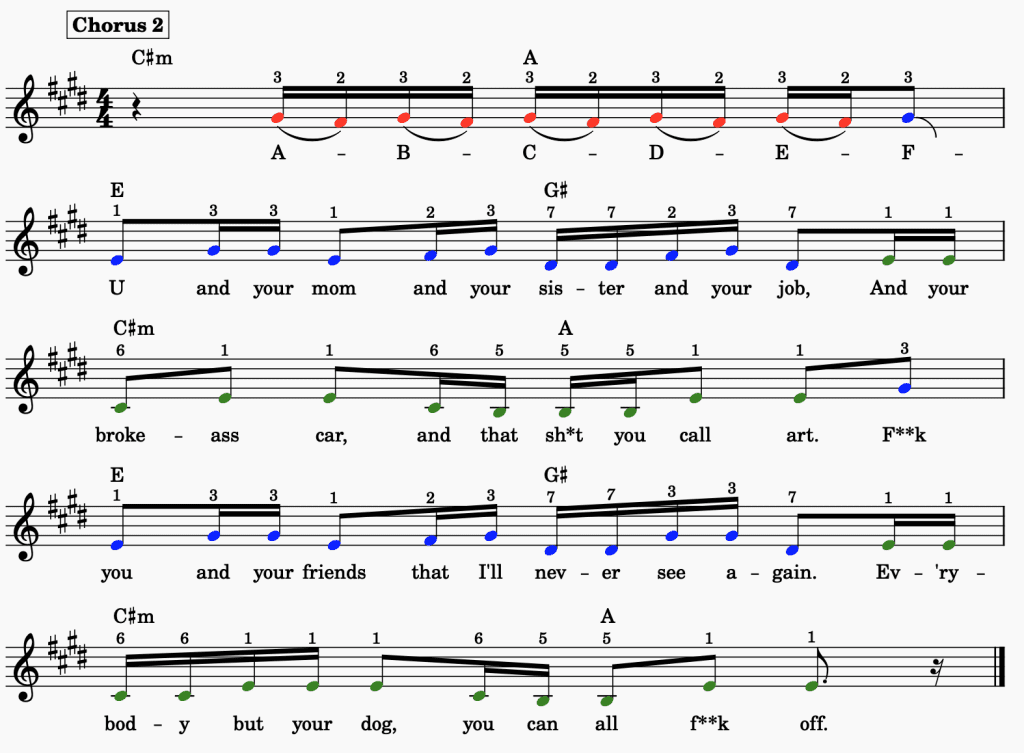

*Note that all images and analysis shown below pertains to chorus 2 unless otherwise noted. Differences between chorus 2 and choruses 1, 3 and 4, if any, are detailed in each line grouping’s analysis.
Part a: A-B-C-D-E
Part b1: F-U
Line 1 of the second chorus is composed of sub parts a and b1. Sub part a comprises the song title hook, which is presented with a highly simple and singable A.M.P. melody that alternates between scale degrees 2 and 3. Sub-part b1 follows by descending from scale degree 3 to 1, which along with the shift to an eighth-note rhythm sets the stage for the similar melodies that define the ensuing lines.
Chorus 1 Variation
The first chorus omits the song title hook, instead opting to kick off with the b1 melody that delivers the “F**k you” lyric.
Part b2: And your mom
Part b3: And your sis-ter
Part b4: And your job
Line 2 is composed of three sub parts: b2, b3 and b4. The three sub parts heighten memorability and cohesion by featuring very similar rhythms and melodic shapes to the preceding sub part b1, which locks the listener into the nursery-rhyme-like flow. The cohesion is further heightened by returning to scale degree 3 on the lyric “your,” which is consistently placed on the “e” of each beat, providing a foundation to the line.
However, there are also subtle melodic differences between lines that prevents the catchy flow from becoming overly monotonous (reference graphs and sheet music for details).
Part c1: And your broke-ass car
Line 3 is composed of sub part c1. It features a somewhat similar melodic and rhythmic flow compared to the preceding lines, which maintains cohesion, while the differences subtly heighten interest.
Part c2: And that sh*t you call art
Line 4 is composed of sub part c2. While its qualities are highly similar to line 3, it drops to a lower register centered on scale degree 5 and a sixteenth note rhythm before concluding on the familiar root.
Part b1: F**k you
Line 5 is composed solely of sub part b1, which was initially featured at the end of line 1 along with the now omitted “A-B-C-D-E-F-U” song title hook.
Part b2: And your friends
Part b3: That I’ll nev-er
Part b5: See a-gain
Line 6 is composed of three sub parts: b2, b3 and b5. Sub parts b2 and b3 are identical to line 2, while part b5 varies slightly by featuring a pattern of 3-3-7 as opposed to 2-3-7.
Part c3: Ev-‘ry-bod-y but your dog
Line 7 is composed of sub part c3, which is identical to line 3’s part c1, save for a slight rhythmic variation.
Part c4: You can all f**k off
Line 8 is composed of sub part c4, which is identical to part c2 in line 4, save for lyric-accommodating rhythmic and melodic variations.
Chorus 4 Variation
Chorus 4 features the most significant melodic variation in the song with an embellishment over the final lyrics. This serves to showcase GAYLE’s vocal chops while bringing the song to a conclusion on a fresh, engaging note (see illustration below for details).
Chorus 4, Lines 7-8
*The blue box illustrates a difference in chorus 4 compared to chorus 2
abcdefu’s first vocal break is composed of one, two-line stanza that follows an AB main melodic structure. The second vocal break is nearly identical, with an additional repetition of the first line to create an ABA main melodic structure.
Vocal Break Melodic Part Structure: At-a-Glance
Vocal Break Melodic Direction: At-a-Glance
The vocal breaks consist entirely of recycled melodies from other song sections. The part A melody recycles melodic content from the pre-chorus but with a new “nah” nonsense lyric, which turns it into a notable vocal hook.
Pre-Chorus (Line1)
Vocal Break (Line 1)
The part B melody recycles the song defining “A-B-C-D-E-F-U” hook from the chorus verbatim.
Together, these back-to-back hooks take abcdefu’s infectiousness and memorability to the next level while preventing redundancy due to their new context.
abcdefu features expert use of rhymes and other connection accentuators that ensure the song remains lingering in the listener’s head long after it ends. Among them are logically unfolding end-of-line rhyme schemes, strategically placed internal rhymes, double and triple rhymes, alliteration, repetitive lyrics, and the mirroring between rhyme schemes, syllabic structure and melodic structure to heighten cohesion and connectability.
Key
A, B & C: End-of-line rhymes
X: Non-rhymes
Lyrics: The primary rhyme at the end of each line
Colors and rhyme schemes are unique to each section
Key
Numbers: Denotes the total number of syllables in a line.
Numbers in parentheses: Denotes the number of syllables in a specific line segment. Segmentation is achieved through melodic or rhythmic contrast within a line or the use of rests between segments. Lines without parenthesis have no segmentation. Reference the Vocal Melody section of the report for further details.
Colors: Reflect song sections (note that they do not relate to the colors used in the rhyme tables)
Key
A, B & C: End-of-line rhymes
X: Non-rhymes
Underline: Repetitive lyrics
Highlight: Alliteration
Colors and rhyme schemes are unique to each section
*For simplicity of analysis, note that only lyrics connected by both rhyme and another notable characteristic (i.e., proximity, placement, melodic connection, etc.) are shown in each table. Lyrics that rhyme but are otherwise unconnected are not noted.
**Note that repetitive lyrics at the end of lines have been assigned rhyme schemes for connection illustration purposes only; a word technically cannot rhyme with itself.
End-Of-Line Rhymes
Verse 1 is composed of two, four-line stanzas, following a repeated AAAB rhyme scheme that mirrors the melodic structure and closely matches the syllable structure. The A scheme features the “IH” commonality in the lyrics “end-ED,” “sh*t,” “ques-TIONS,” and “at-ten-TION,” to name a few. The B scheme features the “AY” commonality in the lyrics “place” and “ways.”
Internal Rhymes, Alliteration & Other Connection Accentuators
The first verse features a number of other connection accentuators, including:
- Triple rhymes that bolster the end-of-line rhymes in both stanzas with the lyrics “it end-ed,” “ask-in’ ques-tions,” “at-ten-tion,” “con-nec-tion,” and “af-fec-tion.”
- A plethora of in-line and cross-line internal rhymes, often featuring similar syllabic placement. One example is the “EH” commonality, in lyrics such as “meant,” TEXT-in’,” and “NEV-er,” as well as the triple rhymes “at-TEN-tion,” “con-NEC-tion,” and “af-FEC-tion.”
- Notable alliteration at the beginning and end of the section.
- Lyrical repetition across lines that further heightens familiarity, including “when,” “in the,” and “for.”
Lines in the verse are relatively long, landing between 11 and 12 syllables. However, the melodic segmentation employed in each line, save for lines 4 and 8, breaks each of these longer-length lines into two shorter, easier-to-digest segments.
End-Of-Line Rhymes
Verse 2 is composed of one, four-line stanza, following an AAAX rhyme scheme that lines up with the syllabic and melodic structure and is nearly identical to the verse 1 rhyme scheme. The sole A connection features the “IH” commonality over the repeated lyric “it.”
Internal Rhymes, Alliteration & Other Connection Accentuators
In addition to the end-of-line repetition, the second verse features a host of other connection factors, including:
- The double end-of-line rhymes “gave it,” “take it,” and “be-CAME it,” further bolstering the end-of-line connectivity.
- Similarly placed internal rhymes, most notably the “UH” commonality placed on the fourth syllable in lines 1-3 in the lyrics “just,” “NOTH-in’,” and “ev-‘ry-ONE,” as well as “BE-came it,” (which features an altered pronunciation).
- The repetition of the similarly placed “so I” lyric in lines 1 and 3.
Verse 2 remains in line with verse 1, featuring similar line lengths and segmentation.
End-Of-Line Rhymes
The pre-chorus is composed of one, three-line stanza, following an AXA rhyme scheme. This mirrors the main melodic and syllabic structure, providing an extra level of cohesion between the lyrics and the vocal melody. The A rhyme scheme features the “OW” commonality in the lyrics “now” and “out.”
Internal Rhymes, Alliteration & Other Connection Accentuators
The pre-chorus also features a host of other factors that bolster its ability to connect and be remembered by the listener. A few of the most notable include:
- A plethora of in-line and cross-line internal rhymes along with similar placements.
- Lyrical repetition of “I was” at the beginning of lines 1 and 2 and “it” at the end of lines 1 and 3, the latter creating a double end of line rhyme with the lyrics “now” and “out.”
The pre-chorus is composed of two longer lines of 11 and 12 syllables divided by a shorter, 7-syllable line.
*Note that the above chart reflects choruses 2 and 4
End-Of-Line Rhymes
Chorus 2 (depicted in the chart) is composed of two, four-line stanzas following an almost identical ABBB/AXBB rhyme scheme. Lines 1 and 5 are connected by the repetition of the lyric “you,” while lines 2-4 and 7-8 are connected by the “AH” commonality in the lyrics “job,” “car,” “art,” “dog,” and “off.” Note that GAYLE alters her pronunciation of some of the lyrics to make a stronger rhyme connection.
Internal Rhymes, Alliteration & Other Connection Accentuators
In addition to its memorable end-of-line rhyme scheme, chorus 2 features a host of other connection-enhancing factors. Among them are similarly placed internal rhymes along with the “b-c-d-e” portion of the clever song title hook, and a high degree of lyrical repetition.
Chorus 1 Variation
Chorus 1 features the same lyrics as choruses 2 and 4, save for the omission of the song title hook in line 1.
Chorus 3 Variation
Chorus 3 features a unique lyrical changeup, adding an additional C scheme in lines 3 and 4 with the “OW” commonality on the lyrics “couch” and “sounds.”
Lines in the chorus are notably shorter than the verses and pre-choruses, save for lines 2 and 6. However, these longer-length lines are segmented into shorter, easier-to-digest segments through melodic and rhythmic segmentation (see vocal melody section of the report for more details).
*Note: The chart above reflects vocal break 2
End-Of-Line Rhymes
The second vocal break is composed of one, three-line stanza that follows an AXA rhyme scheme, mirroring the melodic and syllabic structure. Lines 1 and 3 feature the repetition of the nonsense “nah” lyric, sandwiching an additional appearance of the slightly varied “A-B-C-D-E, F off” song title hook.
Vocal break 1 varies slightly by featuring a single appearance of the nonsense “nah” hook followed by the original song title hook, “A-B-C-D-E-F-U.”
Internal Rhymes, Alliteration & Other Connection Accentuators
The vocal break’s main connection accentuator is lyrical repetition along with the back-to-back internal rhymes in the song title hook.
Lines in the vocal break are nearly equal in length, with lines 1 and 3 employing subtle segmentation that breaks them into shorter four-syllable segments.
abcdefu is a love/relationships-themed song about a protagonist (GAYLE) who experiences a teenage heartbreak and is deeply angered by her ex’s behavior following the breakup. Her feelings are succinctly summarized with the clever song title hook “A-B-C-D-E-F-U,” a play on the alphabet that both insults her ex’s intelligence while telling them off in a particularly scathing and memorable manner.
Throughout the song, a host of expert lyrical techniques are employed that go both with and against the grain. Among the more common are delivering the relatable lyrics in a conversational manner, using an effective balance of common and clever lyricism, incorporating aspects of the A.I.D.E. principle (action, imagery, detail devices, emotion) to heighten interest, featuring a nonsense lyric hook, and the logical unfolding of lines both within and across sections, to name just a few.
Conversely, the song goes against the grain most notably with its chorus. Among its atypical chorus qualities are providing the listener with the summation at the top of the song before the backstory is established (i.e. having the chorus appear before the first verse), using ample profanity (most notably in the song title hook), and changing up the chorus lyrics, which is rarely done. However, all of these decisions were done with an intent and purpose that served the song perfectly.
Additionally, abcdefu is also a perfect example of “writing what you know.” The lyrics pertain to GAYLE’s own personal experiences with heartbreak, which bolstered her ability to deliver the song in a compelling manner and heighten its connection with her teen girl fanbase.
abcdefu features a love/relationships lyrical theme, which has historically been most popular among non-hip hop Hot 100 Top 10 hits. Furthermore, its underlying breakup subject matter is highly relatable to most listeners; most notably GAYLE’s teen girl fanbase.
Lyrical Themes In Non-Hip Hop Hot 100 Top 10 Hits: 2017 – 2021
Narrative Flow: At-A-Glance
KEY
POV (Point of View): The point of view from which the narrative is being communicated (GAYLE, EX, FRIENDS)
Tone: The tone of the line, either positive (P) or negative (N)
(Parentheses): Implied
In lieu of an intro, abcdefu immediately opens with the scathing chorus lyrics “F**k you, and your mom, and your sister, and your job.” This highly effective opening line achieves a host of things, including:
- Immediately grabbing the listener’s attention and hooking them into the song.
- Establishing GAYLE’s intense disdain for a yet-to-be disclosed person.
- Piquing the listener’s curiosity to find out more by providing the summation before the backstory is established.
- Establishing the song’s overall tone, which is effectively complimented by GAYLE’s vocal delivery and instrumental accompaniment.
Following this powerful opening statement, the other lines in the section follow suit, using an effective combination of non-descript imagery, adjectives and slang to communicate GAYLE’s intense feelings in a conversational, resolute and relatable manner.
However, one notable exception to the section’s scathing tone is line 4’s “everybody but your dog.” The inclusion of this seemingly out of place line is highly important for a few key reasons:
- It paints GAYLE in a favorable light, which makes the listener more sympathetic to her plight as they find out more in the ensuing sections.
- It provides light-hearted relief against the section’s scathing lyrics.
- It stands out as one of the most memorable lines in the song due to its cleverness and the pronounced contrast it provides against the other lines in the section.
Following the scathing and summative first chorus, verse 1 provides insight into the backstory that led to GAYLE’s feelings of contempt. The section unfolds in an engaging manner, with each line pairing providing unique detail into the aftermath of the relationship:
- Lines 1 & 2: Conveyed from GAYLE’s point-of-view, these lines illustrate her trying to take the high road after the relationship’s demise while depicting her ex in a negative light. Note that these favorable views of GAYLE tie in with the “dog” comment that was previously established in the chorus, further heightening the listener’s connection and sympathy towards her.
- Lines 3 & 4: Shifts to her ex and her friends, providing insight into his invasiveness and establishing that her friends had him pegged as a bad guy right from the get-go.
- Lines 5 & 6: Focus on her ex and provide additional insight into his abhorrent character, depicting him dating a girl that GAYLE hates “for the attention.” However, this is cleverly countered in the ensuing line by GAYLE’s sarcastic lyric “she only made it two days, what a connection.” Note that this rebuttal is important as it portrays GAYLE from a position of strength.
- Lines 7 & 8: Sums up the essence of the section, namely her ex trying to get her attention and affection but in the “worst ways” possible.
Furthermore, lines throughout the verse are communicated in a conversational manner, with an effective use of emotive lyricism, non-descript imagery, action and idiom to hammer home the storyline in a compelling manner.
Following the summation and backstory establishment in the preceding chorus and verse, respectively, the pre-chorus summarizes what the listener has learned while cleverly setting up the ensuing “A-B-C-D-E-F-U” song title hook with the lyric “so let me spell it out.”
Note that this lyrical set up was imperative to bolster the hook’s arrival. Had GAYLE instead stated something like “so let me say it loud, A-B-C-D-E-F-U,” the hook’s impact would have been notably diminished.
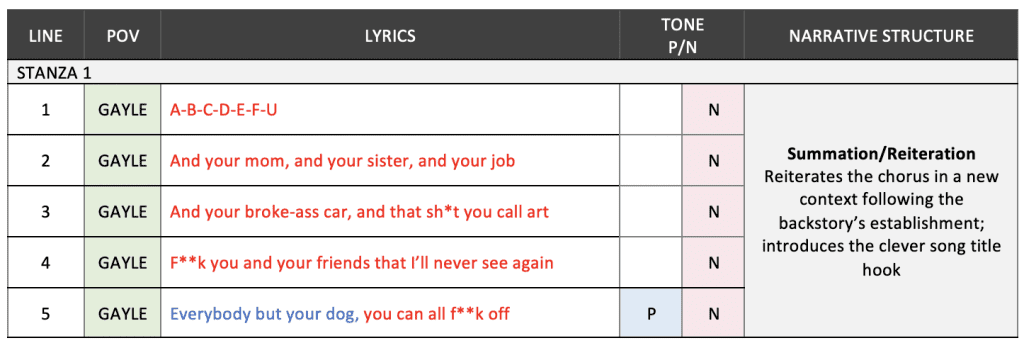


*Note that the table has been adjusted from the vocal melody and production segments to match the narrative flow
Following the verse and pre-chorus, chorus 2 reiterates GAYLE’s scathing summation, this time with the clever, song-defining “A-B-C-D-E-F-U” hook at the top of the section. Note that the chorus’s new context provides it with much more gravity and meaning compared to the first time around, where it served more to intrigue the listener to find out why GAYLE felt this way about a particular person.
Chorus 3 Development
While most hit song choruses feature the same lyrics with each iteration, abcdefu “breaks the rules” by providing a lyrical development in line 3 of its third chorus:
- Omitted: “And your broke-ass car, and that sh*t you call art”
- Added: “And your Craigslist couch, and the way your voice sounds”
This lyrical changeup, while atypical, serves a few key purposes:
- It prevents all four choruses from becoming overly redundant.
- It provides additional insight into the unfavorable qualities of GAYLE’s ex while remaining in-line with the chorus’s other lyrics.
- The use of the specific lyric “Craigslist couch” provides additional detail into the ex’s sense of taste, similar to the lyric “that sh*t you call art,” driving home GAYLE’s resentment by continuing to insult her ex.
A few other recent hits that go against the grain by providing a lyrical development in the chorus are Good 4 U (Olivia Rodrigo), All Too Well (Taylor Swift), and 1-800-273-8255 (Logic).
The vocal break post-choruses that directly follow choruses 2 and 3 serve to reiterate the song title hook along with the introduction of the unique nonsense “nah” hook. Note that while the “nah” lyric doesn’t have any meaning on its own, its reminiscence to the dismissive sentiment behind Steam’s 1969 hit, Na Na Hey Hey (Kiss Him Goodbye) serves to cleverly bolster GAYLE’s feelings toward her ex.
Following the first vocal break post-chorus, verse 2, which is half the length of verse 1, provides additional insight into the backstory while remaining on point with the song’s main message and lyrical flow.
The section is structured similarly to verse 1, with the first line providing a positive statement about GAYLE, followed by more negative insight into her ex’s character and behavior. Additionally, the listener is shown how these developments affected both GAYLE and her ex, providing the story with heightened dimension while further bolstering the listener’s empathy toward GAYLE.
Song titles fall on a spectrum ranging from unique, clever, attention-grabbing and/or powerful (e.g. 712PM, N95, and Running Up That Hill (A Deal With God)), to those that possess more of a universal/generic quality (e.g. First Class, I Like You (A Happier Song) and Woman).
abcdefu leans heavily toward the attention-grabbing end of the spectrum due to its reference to the English alphabet as well as the clever twist on a common phrase, “F-you.” This instantly piques the listener’s curiosity concerning the song’s narrative, while functioning as an incredibly catchy and memorable song-title hook.
One-worded song titles have consistently been the most popular among non-hip hop Hot 100 Top 10 hits over the last several years. Despite being a bit more phonetically dense, abcdefu maintains the same simplicity and memorability associated with one-worded song titles.
Song Title Word Count: Non-Hip Hop Hot 100 Top 10 Hits (2017-2021)
The title “abcdefu” appears five times in the song. The 1-5 song title appearance range notably increased in 2020, almost tripling in prominence compared to the preceding year and surpassing the 6-10 range, which had been most popular in the year’s prior. And while its prominence dipped in 2021, the 1-5 range remained most popular along with the 6-10 range at 30% of songs, each.
In terms of song title placement, abcdefu appears in choruses 2, 3 and 4 as well as the ensuing vocal break post-choruses 1 and 2. However, one section where it is notably omitted is chorus 1 at the very top of the song. This strategic move saves the song’s most recognizable and iconic component for later, after the listener has gotten past the 30 second mark and the song has already counted as a stream.
Song Title Appearances: Non-Hip Hop Hot 100 Top 10 Hits (2017-2021)
Song Title Placement: Non-Hip Hop Hot 100 Top 10 Hits (2017-2021)
abcdefu is a unique, clever, powerful expression of GAYLE’s resentment toward her ex and everything associated with him. The reasons for her disdain first become apparent across the first verse and pre-chorus, followed by additional development in the second verse.
The song title first appears in the second chorus, accentuated by a partial accompaniment pull and robust gang vocals, driving home the summative message. The title is further accentuated in the high-energy vocal break post-chorus sections by being paired with the dismissive nonsense “nah” hook (reminiscent of Steam’s 1969 hit, Na Na Hey Hey Kiss Him Goodbye) that jibes with the mood and overall narrative.
This section spotlights abcdefu’s familiarity and standout factors relative to the Hot 100 Top 10, both as a whole and independently of the hip hop genre specifically, in the quarter before the song entered the Hot 100 Top 10 (Q4 2021). The familiarity factors enable abcdefu to connect with a mainstream audience more easily, while the more atypical factors help it to stand out from the pack.
Of the categories benchmarked in the table below, abcdefu is in-line with 43% of the top characteristics in the overall Hot 100 Top 10 and non-hip hop hits specifically.
“D” Section: A section that provides a pronounced vocal, lyrical, instrumental and/or energy level departure around two-thirds of the way into a song. “D” sections can include bridges, bridge surrogates, and diversified recycled sections.
*Falls within a 5% margin of error
abcdefu features a host of characteristics that are in line with recent hit song trends and best practices, which makes it sound familiar to audiences and bolsters its ability to connect. Among them are its K.I.S.S. ME melodies (Keep It Simple, Singable, and Memorable), highly catchy and memorable vocal hooks, a relatable love/relationships lyrical theme and breakup subject matter, and the inclusion of popular instruments, such as drums, synth (both non-bass and bass) and electric guitar, to name a few.
In addition to its familiar qualities, abcdefu also features some unique and atypical characteristics that helped it to stand out from the pack and get noticed. Some of the most notable include:
- Rock Primary Genre: While not atypical in its own right, within the scope of the Hot 100 Top 10, songs falling within the rock primary genre have been few and far between in recent years. Over the five-year period of 2017-2021, only 3% of Top 10s (9 of 301 songs) leaned toward the rock end of the spectrum.
- Sub-Genres & Influences: abcdefu’s expert fusion of rock, pop, punk and alt/indie influences enabled it to effectively stand out among its mainstream contemporaries. In fact, its alt/indie and punk influences were shared with only one other Hot 100 Top 10 hit in the last decade – Olivia Rodrigo’s Good 4 U.
- Atypical Chorus Qualities: abcdefu notably goes against the grain of most non-hip hop hits by utilizing a few uncommon techniques within its four chorus sections. Among them are kicking off with the chorus as opposed to an intro (it was one of only two songs in the first quarter of 2022 to do so), omitting the song title hook from the first chorus, and changing up the lyrics in the third chorus (the vast majority of hit song choruses feature the same lyrics).
- Unique Hooks: While virtually all hit songs have notable hooks, some are cleverer than others, with abcdefu being a perfect case-in-point. Most notable is the song’s “A-B-C-D-E-F-U” song title hook, a clever play on the alphabet that both insults GAYLE’s ex’s intelligence while telling them off in a particularly scathing and memorable manner. Additionally, while the song’s “nah” nonsense hook has been used throughout the ages, here its reminiscence to the dismissive sentiment behind Steam’s 1969 hit, Na Na Hey Hey (Kiss Him Goodbye) serves to cleverly bolster GAYLE’s feelings toward her ex.



